2020 Research and Creative Activity Day
UAF celebrates undergraduate research and creative activities every spring.
All UAF undergraduate students are invited to present their work at this event. Research
posters, presentations, displays and demonstrations of creative projects are welcome
from every academic discipline.
Save the date! We will hold the next Research and Creative Activity Day on Tuesday, April 6, 2021.
We were not able to hold the event in 2020 due to COVID19, so we have asked students to provide an extended abstract and their poster (when available).
Creating a Lightweight Concrete and Making a Concrete Canoe
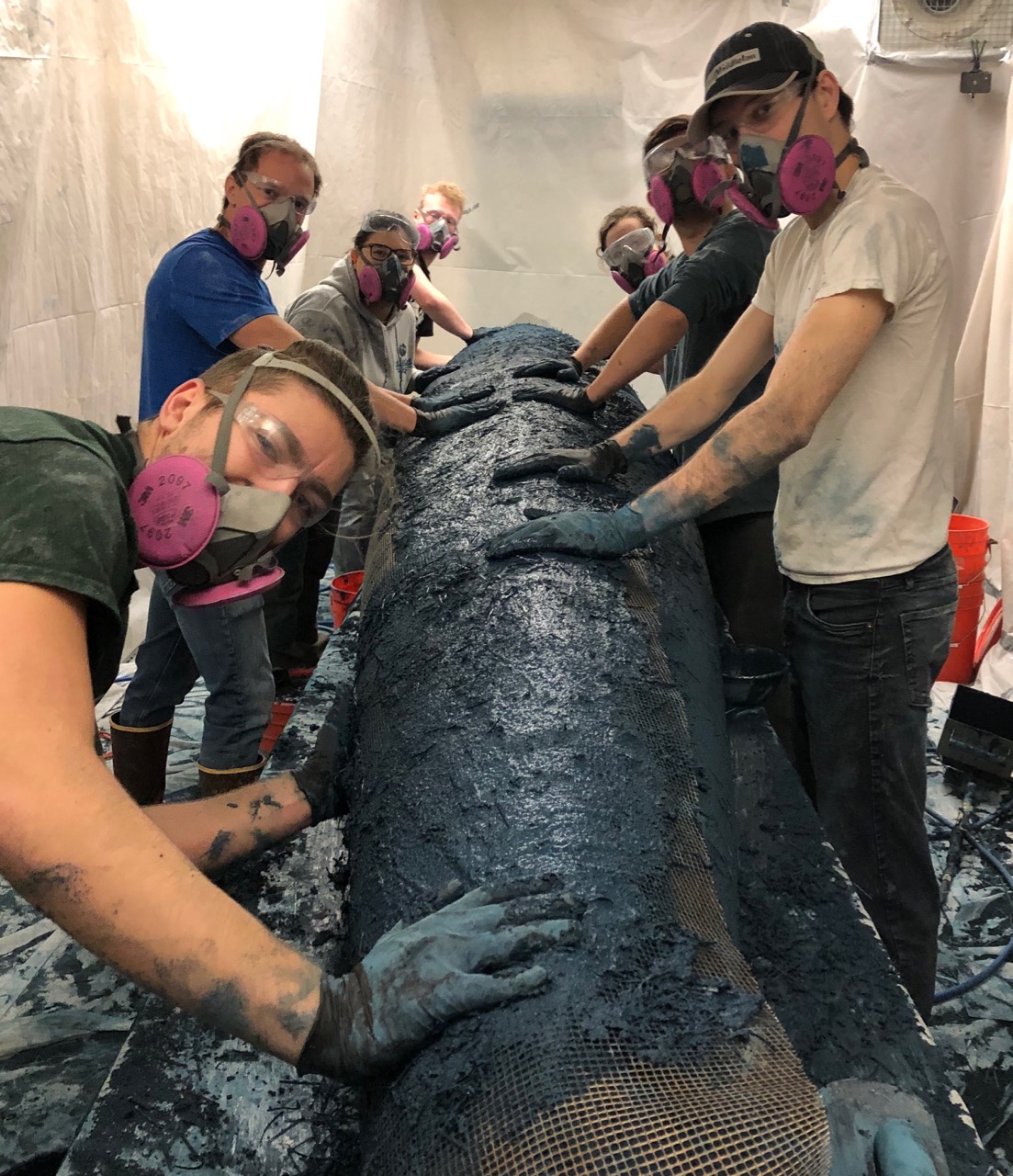
Jason McKee, Wenshi Fisher, Jesse Nix, Caitlin Hanna, Monroe Morris, Jenni Kelbesadel,
Josh Klina, and Jordan Zelhuber
Mentor - Nathan Belz
Our club competes in a national competition held by ASCE (American Society of Civil Engineers). Our task is to design and build a high-performing canoe from concrete that can support four adult paddlers under strenuous conditions. Every year we create a new theme that will be the framework for all aesthetic choices of the project. This year we named our boat Umiaq, the Iñuit boat frame covered with skin, it is used for travel and subsistence practices. Our team creates a new mix design for every year along with a hull design. While refining the mix design there are multiple tests implemented to assess the structural integrity of the concrete. After the development and testing phase, we select a structural and aesthetic mix. To further tie in our theme we named the structural mix Tulimaaq, the Iñupiaq word for the frame of an umiaq, and the aesthetic mix was named Amiq, the word for the skin cover of an umiaq. The next part of the project is to design the hull of the canoe. This year our hull design program is Fusion 360, an Autodesk application that is centered around the design and rapid modeling of three-dimensional shapes from two-dimensional sketches. We could create multiple complex curves that fit together with minimal seams to form our male mold. When the hull is design is completed, it is then sent to Lifewater, a local company, that will cut the mold of our canoe based on the model we send them. After our work area is sectioned off and covered with plastic sheeting the protect the lab, we can build the concrete canoe. The concrete is left to cure for 28 days in a warm moist environment, then the boat is sanded and sealed. Through the entire process we need to properly document our meeting minutes, hours put in, and deadlines. Besides the creation of the canoe we need to write a Design Paper, MSTS Addendum, visual presentation, and oral presentation for competition.
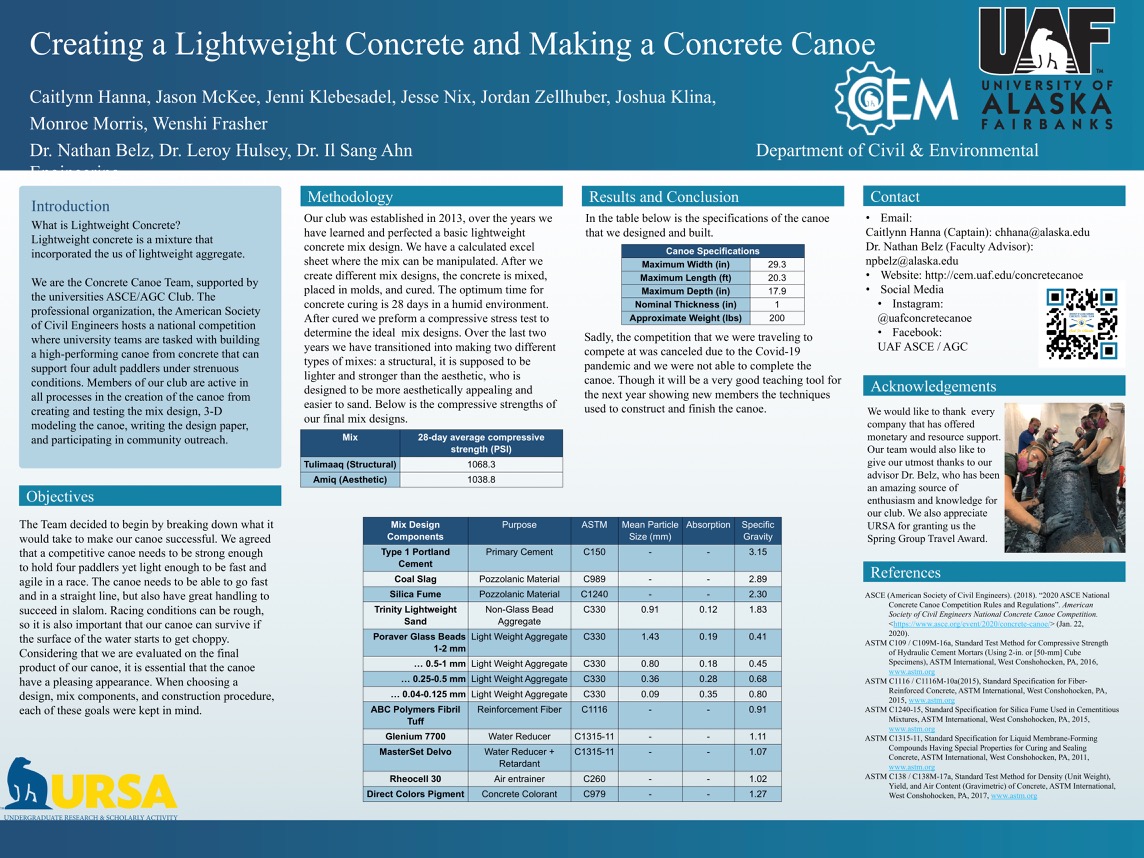
UAF AIAA Design

Zach Barnes, Zion Alioto, and Hannah Fontecchio
Mentor - Michael Hatfield
AIAA hosts a design competition every year called Design Build Fly where teams from
around the world design and build an unmanned aircraft that can fulfill the goals
of the mission. The competition also includes a 5-page design proposal and a 60-page
design report. The rules for the competition are released sometime in September to
October, with the competition happening on the second weekend of April. This year's
competition was based around building a bush plane that could carry passengers for
charter flights, as well as tow a banner.
The plane is tested over the course of three flight missions, as well as one ground
mission. The first of the flight missions confirm that the plane can fly under no-load
conditions. It must take off in under 20 feet, and complete three laps of the course
in under five minutes, and land safely at the end. Mission two is the charter flight
mission. The plane carries a number of passengers and their luggage and gets scored
based upon both the number of passengers carried and the time taken to complete the
mission. The final flying mission is the banner towing mission. The aircraft must
take off in under 20 feet, and then deploy a banner once in flight. From there, the
plane must complete as many laps as it can in 10 minutes and then dispose of the banner.
The plane gets scored by the number of laps it did, as well as the banner length.
The ground mission is a timed run to see how quickly the passengers and luggage can
be loaded and unloaded, how quickly the banner can be mounted, and if the control
surfaces work.
The practical missions give a number of points, which are then added together. This
score is multiplied by the score earned on the design report, as a percentage, giving
the final score.
Our aircraft was a low-winged monoplane, with a single motor. It was powered by lithium
polymer batteries, a change from previous years where the only batteries allowed were
nickel-metal-hydride. The passengers were all located in the center of the fuselage,
one behind the other. The banner mechanism was located beneath the wings. The first
prototype flew in February and crashed due to a failure of the wing-fuselage interface.
The second prototype would have been ready to fly the week after spring break, if
not for the university shutdown.
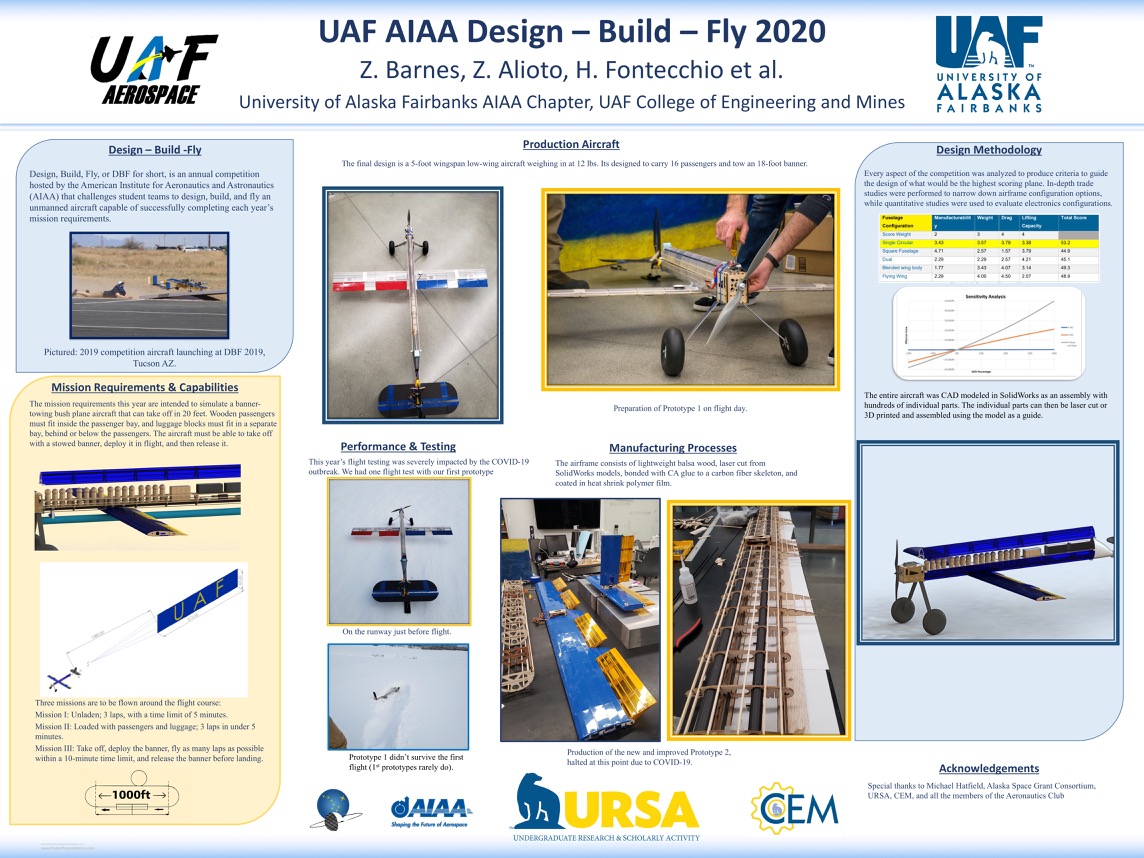
Stress Corrosion Cracking Machine
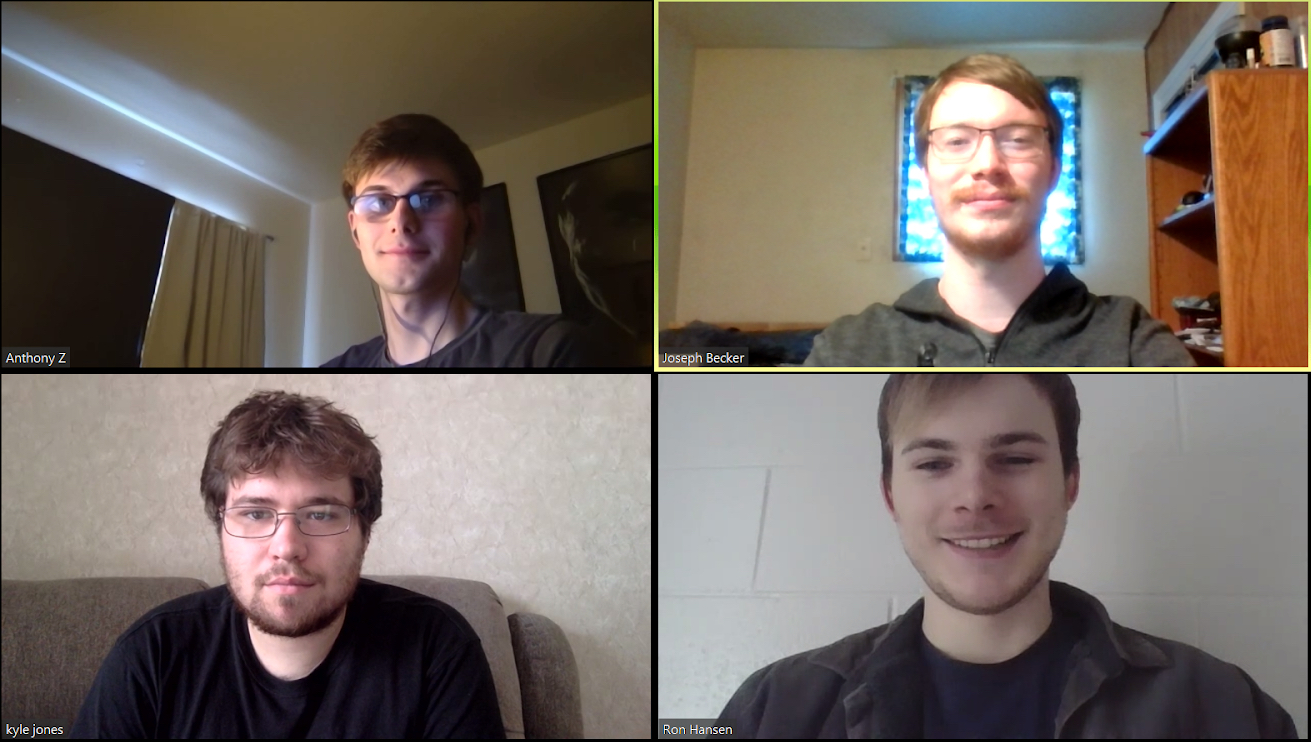
Anthony Zizza, Kyle Jones, Joseph Becker, and Ron Hanson
Mentor - Cheng-Fu Chen
Testing material strength in a corrosive environment often involves extrapolating
from separate corrosive and strength data. Another method involves putting the sample
under a strain and then in a liquid corrosive in a specific order, but this is a time
consuming methodology for running Stress Corrosion Cracking (SCC) tests. A faster
and more representative test involves putting the sample under a low constant strain
while in a corrosive environment. A real life example of this would be the testing
of implants such as for hip replacements to see how they would perform under the stress
of movement while in contact with corrosive internal body fluids. The purpose of our
senior capstone project was to improve on an existing machine design, which would
allow researchers at the university to quickly and efficiently test these material
properties. This SCC testing machine is a low cost solution that could be used to
place samples in a corrosive environment while undergoing a constant test strain.This
form of the test takes just under a week to perform whereas other forms can take significantly
longer.
The capstone project redesigned a number of components of a currently existing SCC
machine to allow it to use modified dogbone samples rather than the compact specimens
currently in use. The system includes a new sealed liquid delivery mechanism, consisting
of a 3D printed shell to hold the corrosive liquid and a window to view the specimen.
This shell replaces the current drip system and will prevent evaporation and ensure
constant concentration of the corrosive liquid used. These changes required modifications
to the structure to accommodate additions, and to redesign the system used to measure
extension. This is a compact system that will allow researchers to run stress corrosion
testing on more unique materials in a more controlled corrosive environment.
We completed the corrosive chamber design, and the structural components are being
manufactured with the designed modifications. Additionally, the device used measurement
for the specimen had to be changed as the existing clip gauge used to measure the
extension would not work for the dogbone specimen. An extensometer would be placed
parallel to the dogbone specimen, spaced far enough away to not interfere with the
corrosive chamber, and will be used to record the extension distance. From the start,
the system was designed with the intention to allow for future modification allowing
research on particular materials in specific corrosive environments.

Retrofit of a UAV to a Tri-Tiltrotor VTOL Aircraft
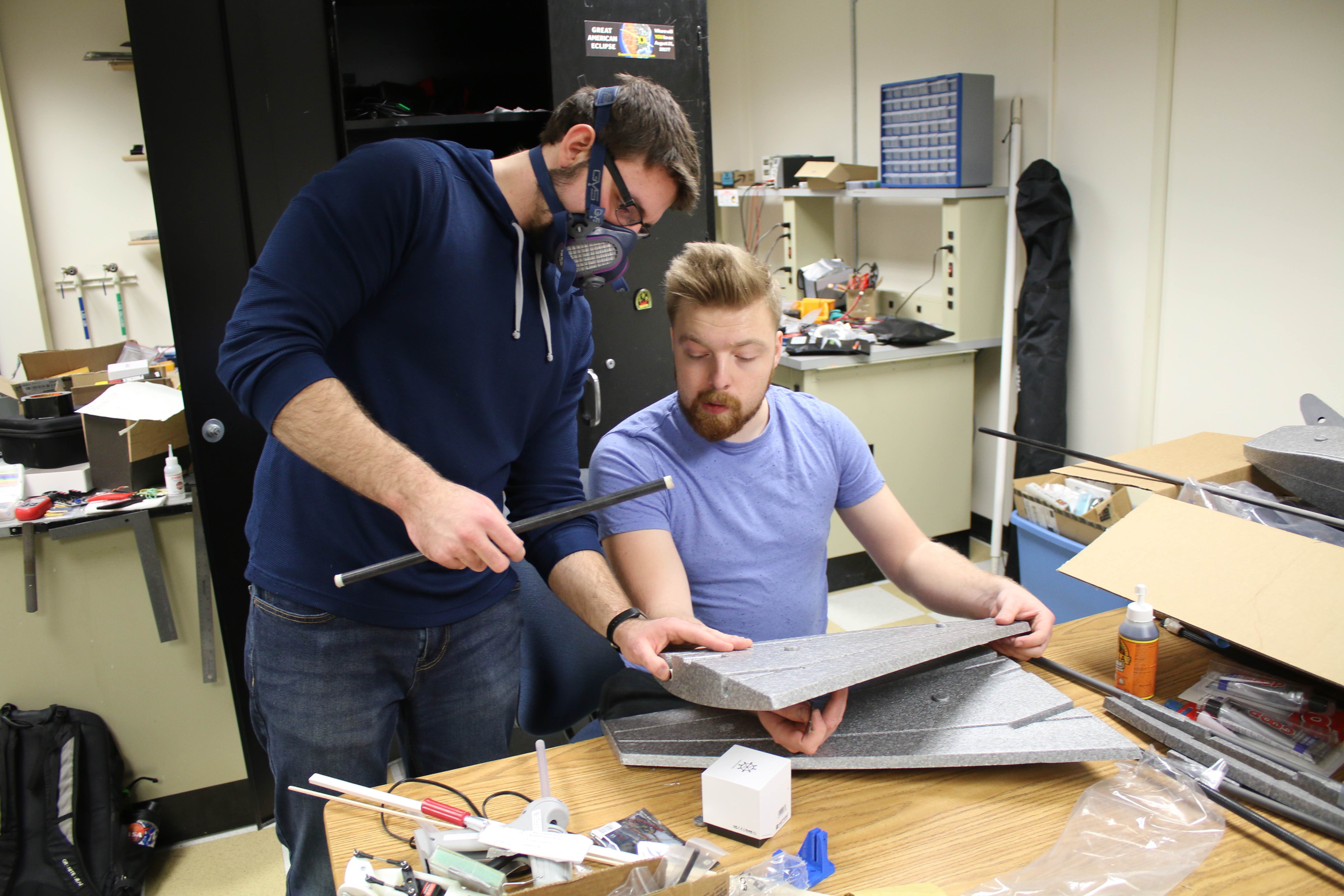
Brian Holst, Michael Radotich, and Vitaly Kulakevich
Mentor - Rorik Peterson
Unmanned Aerial Vehicles (UAVs) have been utilized for the last 50 years, with much
of that time being restricted primarily to military usage. With the introduction of
new technologies, UAVs have adapted increasingly for commercial applications. With
this increase in civilian utilization of UAVs, the reliability and safety features
of must be explored even more thoroughly to ensure public safety. Detect-and-avoid
systems employed on UAVs are critical for ensuring safe flight-paths, and since they
will eventually be installed on other UAVs, they must be tested rigorously on UAV
based testing platforms to establish their reliability and stability.
Each UAV configuration has its advantages and disadvantages. In this project, an aircraft
with vertical take-off and landing (VTOL) capability was desired to allow for the
experimental detect and avoid system to experience minimal forces upon take-off and
landing. Several studies have been done on the reliability, simplicity and efficiency
of VTOL UAVs and it has been found that the best-known systems are tilt-rotors, tilt
wings, or derivatives of the two. The aircraft we utilized was initially a commercially
available fixed wing UAV that was converted into a tilt-rotor VTOL UAV to demonstrate
the process of improving the aircraft to allow for a more reliable testing platform
for detect and avoid technologies.
The aircraft designed in this project is able to take off and land vertically, hover
for five minutes, transition to and from forward flight, and complete a twenty-minute
flight mission. Analysis was performed to determine motor, battery, and propeller
specifications. Tilting motor mount mechanisms and landing gear were designed, and
computational fluid dynamic modeling was performed to assist in developing flight
controls. The prototyping of this design is complete, and programming of the aircraft’s
autopilot is underway. The aircraft is scheduled to begin flight testing as soon as
work at the university resumes.
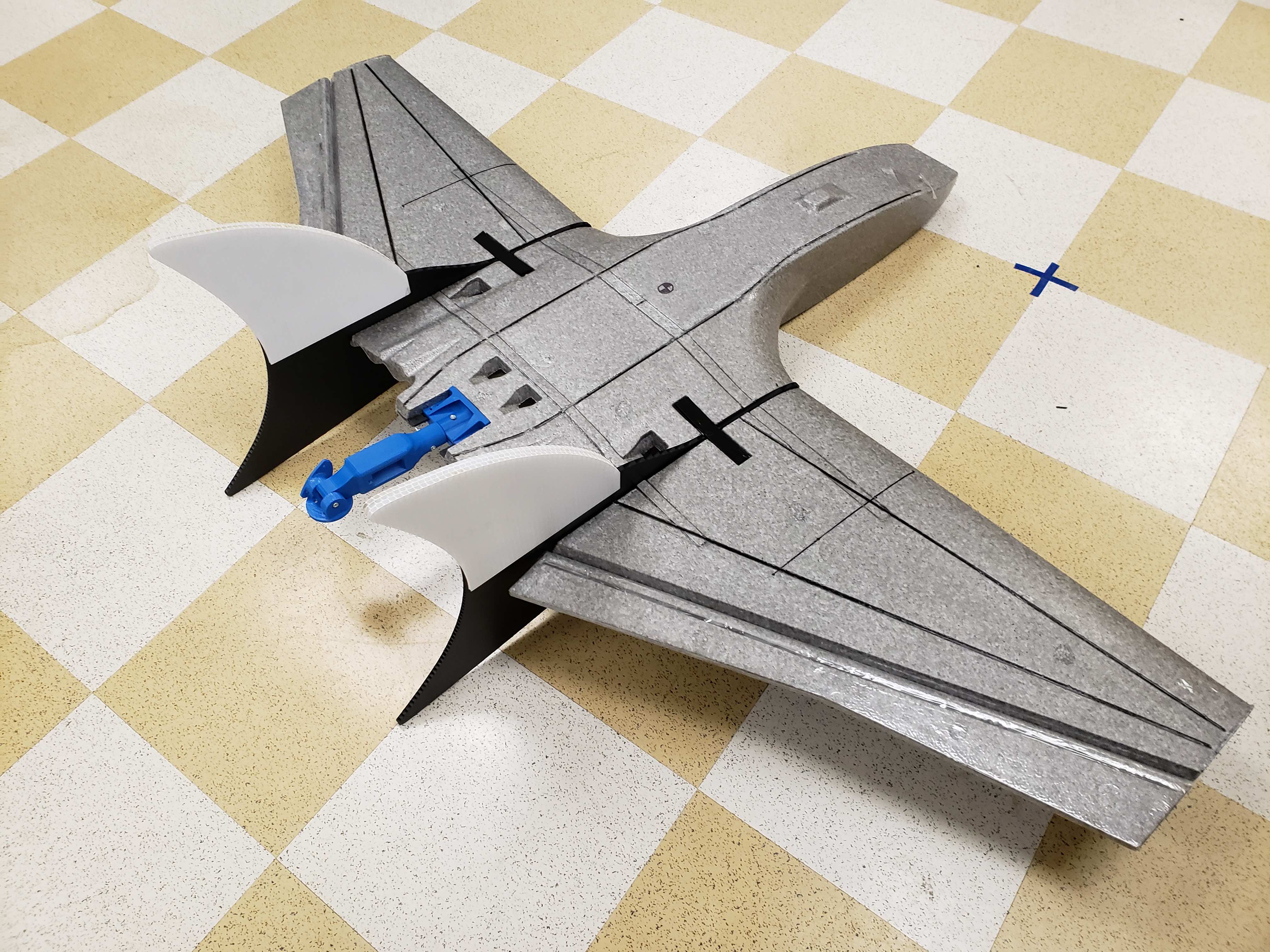
Rural Alaska air quality data visualization and prediction
Chenyi Ling
Mentor - Jonathan Metzgar
The air quality in rural Alaska varies largely. In the summer, wildfires in Alaska
rural areas have a significant impact on air quality due to the smoke and particles
from wood burning. The smokes and ashes from massive wildfires in Alaska rural areas
cause severe air pollution and pose the most insidious threats to health. The air
quality has large variations that are independent of the pollutant emission rate.
Due to Alaska’s vast land area, there is currently very little data available for
rural residents to have an accurate picture of real-time air quality. There is a need
for an easy-to-use and free access tool specifically focused on rural Alaska air quality
to the public.
This project aims to develop a data visualization and prediction tool to fill this
gap. The tool is designed to take advantage of Machine Learning (ML) algorithms to
analyze data from PurpleAir sensor data and provide a detailed air quality graph to
the user according to their location. Real-time air quality measurements with easy
data access provide an unprecedented opportunity to examine air quality in rural Alaska
communities. This real-time data combined with air quality forecasting could provide
guidance on planning outdoor vs. indoor activities (running, hiking, jogging, fishing
vs. staying inside), leading to a healthier life. This project is in progress by the
time of 2020 spring.
In this project, we explored efficient ways to integrate existing data and big data
analysis to improve our understanding of air pollution in rural Alaska. The data collected
from low-cost sensors combined with computed model output to construct a training
dataset for ML models. The goal is to develop a visualization tool and prediction
model using the ML algorithm that can automatically discover features for classification,
for better understanding of air pollution in rural Alaska from different data sources.
The data resource is the PurpleAir sensor. PurpleAir sensors are deployed around the
world. They use laser particle counters that provide an accurate and low-cost way
to measure smoke, dust, and other particulates in the air. The collected data is used
by researchers to understand the effects of forest fires on air quality.
We used MATLAB as the developing environment to preprocess the sensor data, provide
functions to classify and visualize the processed air quality data and to train the
ML models (supervised and unsupervised). The Air Quality Index was calculated using
the definitions from the United States Environmental Protection Agency (EPA).
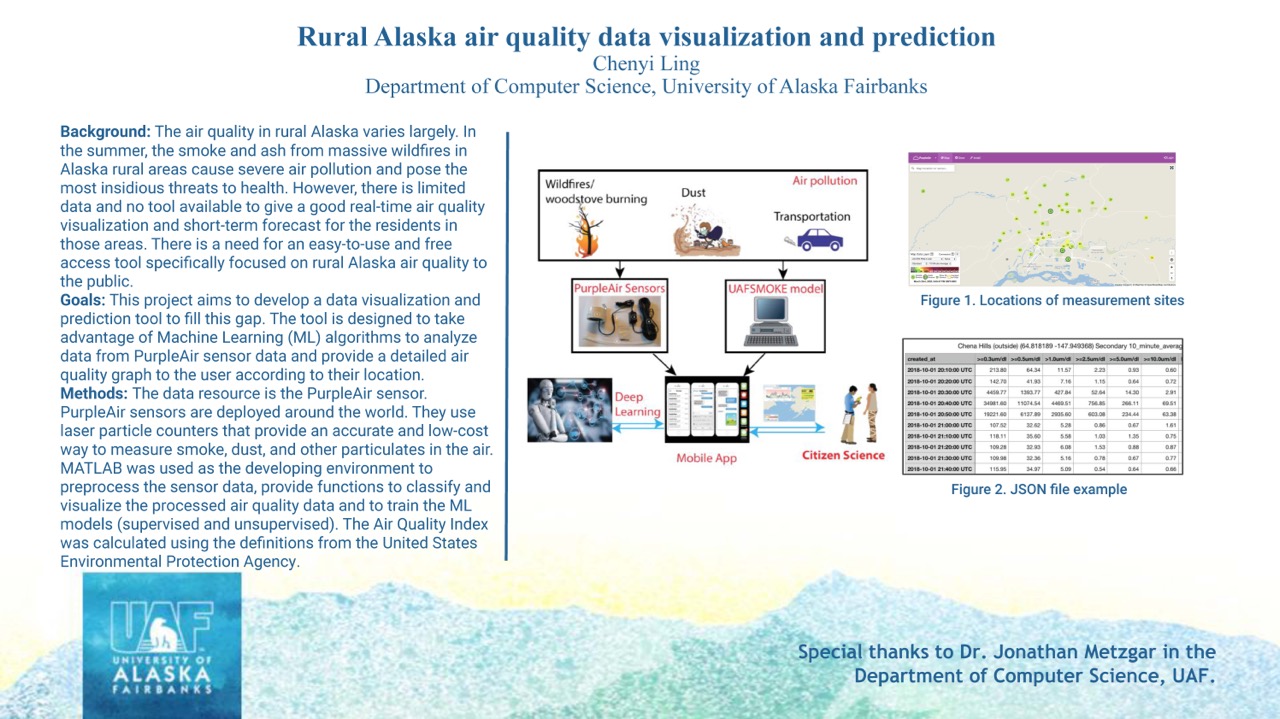
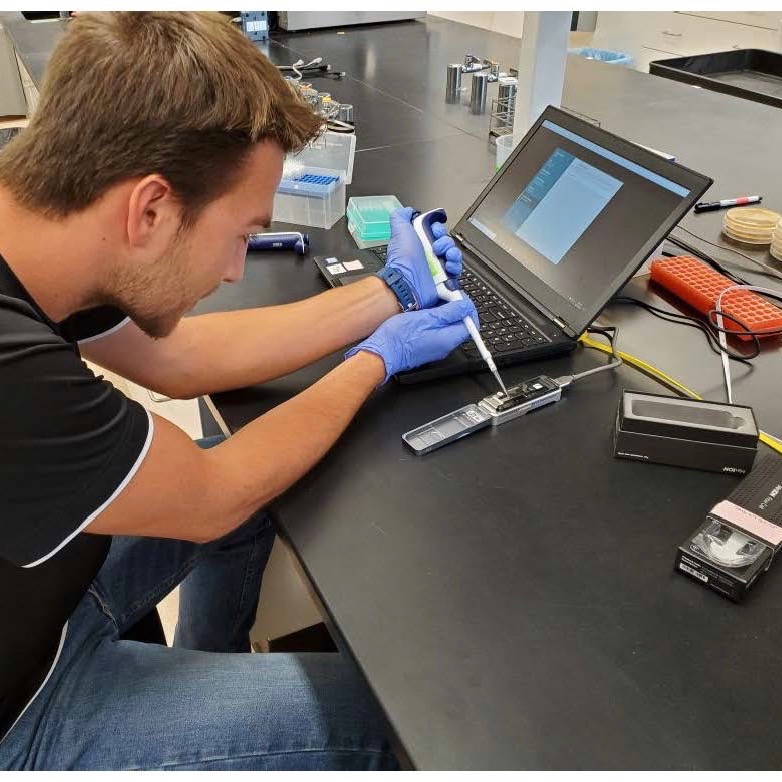 A novel understanding of ASIP in Marmota caligata
A novel understanding of ASIP in Marmota caligata
Reed Thomas
Mentor - Link Olson, UA Museum of the North
The agouti signaling protein (ASIP) gene is questionably arranged and suggests that
conserved noncoding elements (CNEs) have mediated at least one inversion. This study
aims to determine the correct sequence of ASIP in the hoary marmot so that we can
evaluate the functional consequences of the putative mutations. This protein has several
pleiotropic effects, but is best known for interacting with Melanocortin-1 receptors
(MC1R) to signal a secondary messenger system. This cascade initiates the production
of pheomelanin, which is attributed to light fur color. The current ASIP gene region
assembly for Marmota caligata has several assembly gaps and is questionably arranged due to inversions of the conserved
noncoding elements (CNEs), which contain the promotor region and exon 1A. This study
investigates the ASIP gene assembly gaps, as well as maps the CNEs contrary to how
the assembly portrays. I designed primers using Geneious to target the assembly gaps
in the ASIP gene among 48 Marmota caligata individuals. Amplicons were sequenced using a combination of Sanger and minION technology.
I analyzed, assembled, and interpreted the sequences in Geneious to determine how
ASIP is truly assembled, as well as fill in the assembly gaps. The newly assembled
sequences established in this study suggest that the current assembly is incorrect.
Furthermore, these data suggest a high likelihood an inversion occurring among the
duplicate CNEs found in this species. Because the inverted CNEs are similar to the
CNEs responsible for proper expression of ASIP, the region containing all the CNEs
could create a hairpin structure and result in unequal crossing over. The hoary marmot's
sister species, the critically endangered Vancouver Island marmot is exclusively melanistic.
Previous research performed in my mentor’s lab has shown that MC1R, the other gene
attributing to pelage color, did not differ between hoary and Vancouver Island marmot,
leading my mentor and I to suspect that ASIP is responsible for the pelage color differences.
I will perform the same study with Vancouver Island marmots, which may be melanistic
because this region was re-inverted but carried a new mutation back to the promoter
region of ASIP.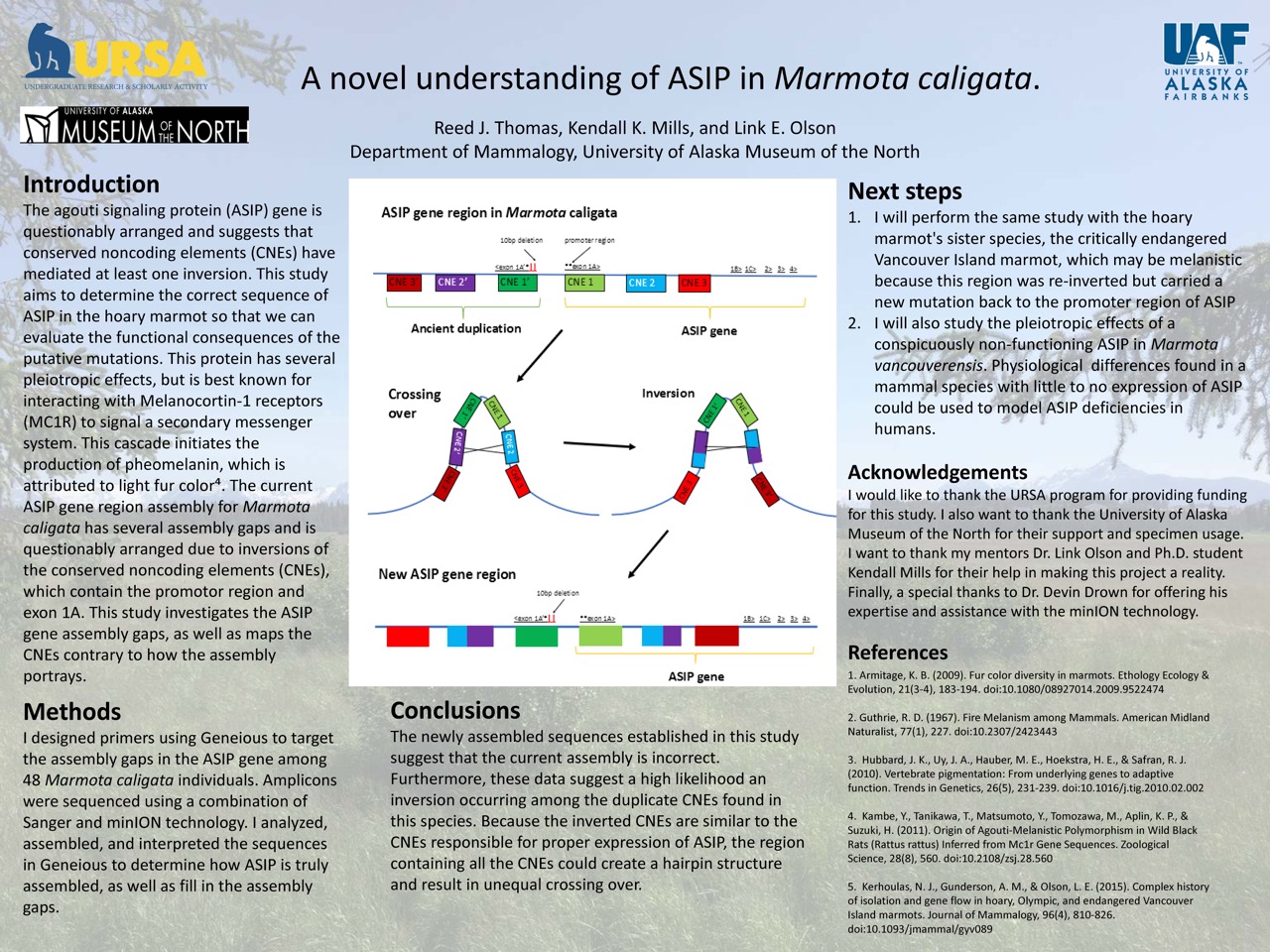
Muskoxen Research
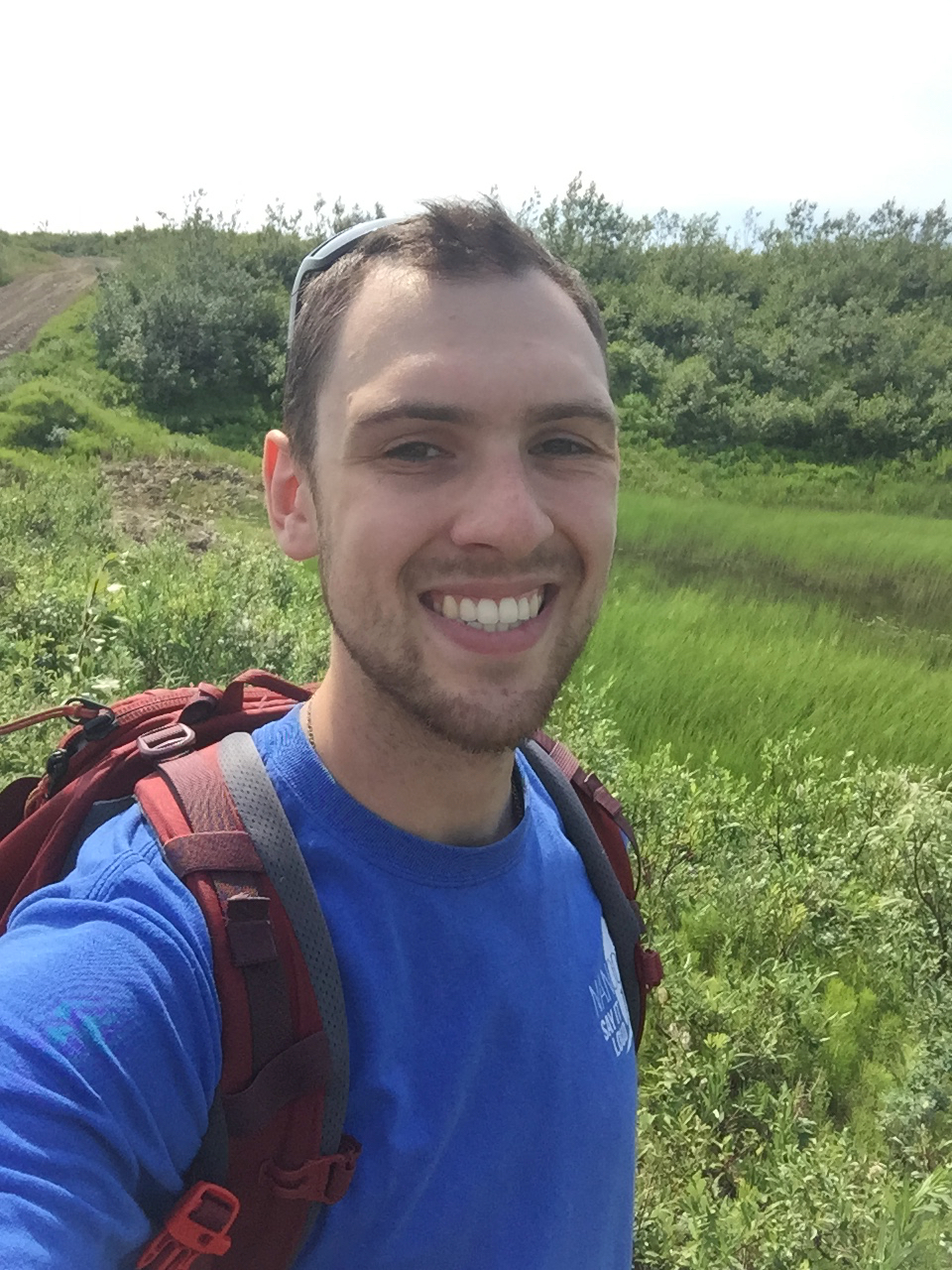
Alex Ashford
Mentor - Claudia Ihl, NW Campus
Muskoxen have increasingly used foraging areas within the city limits of Nome in recent years. In Nome, muskoxen forage on mine tailings and in mining pits created by the local placer mining activities. The presence of muskoxen in town has affected Nome residents in both positive and negative ways. Muskoxen cause disturbances and have attacked dogs but, are also valued as a local wildlife-viewing attraction. Understanding their motivations for being in the town, and how and why they use the habitats they do, is therefore of great interest to the city of Nome. This research projects goal is to test the nutritional content of muskoxen forage in successional species Salix alaxsensis and Salix pulchra looking at protein, fiber, mineral and tannin contents to see if there are differences between vegetation from mine tailings from the natural growth sites, or between young and old vegetation growth between the sites.
For this project I hypothesized that nutrient and mineral content would be greater between muskoxen forage species Salix alaxsensis and Salix pulchra on disturbed mine tailings versus naturally disturbed gravel bars. There is reason to believe that there may be more available nutrients for plant uptake on the recently disturbed placer mine tailings possibly increasing the nutrition of the vegetation present. This could be one reason that muskoxen have become resident wildlife in the Nome area.
For this study sampling sites were selected based upon preferred muskoxen forage habitat; such as disturbed regrowth on mine tailings or mining pits present in the surrounding study area. Willow samples were collected from both Salix pulchra and Salix alaxsensis, two common successional forage species, in both young and old age groups from sampling sites around Nome and gravel bars in nearby rivers. This was done in a way such as to simulate muskoxen herbivory. Collected leaves were then dried in a drying oven at 105 degrees Celsius for 48 hours. Dried samples were sent to the lab to analyze the protein, fiber, mineral and tannin contents.
Overall this project sets up a framework for us to understand some of the potential reasons why muskoxen prefer to forage within the city of Nome. By analyzing the changes or differences between areas in the muskoxen forage, nutrition and minerals we can be more informed on changes that are occurring based upon human activities; such as mining, in our environment. This can lead us to understand mechanisms behind behaviors of the muskoxen in the area and may help to explain why they choose to reside in and around Nome.
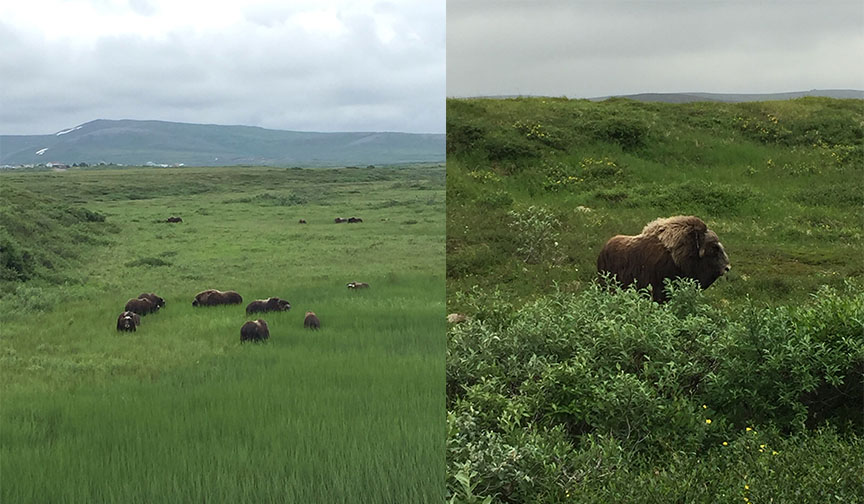
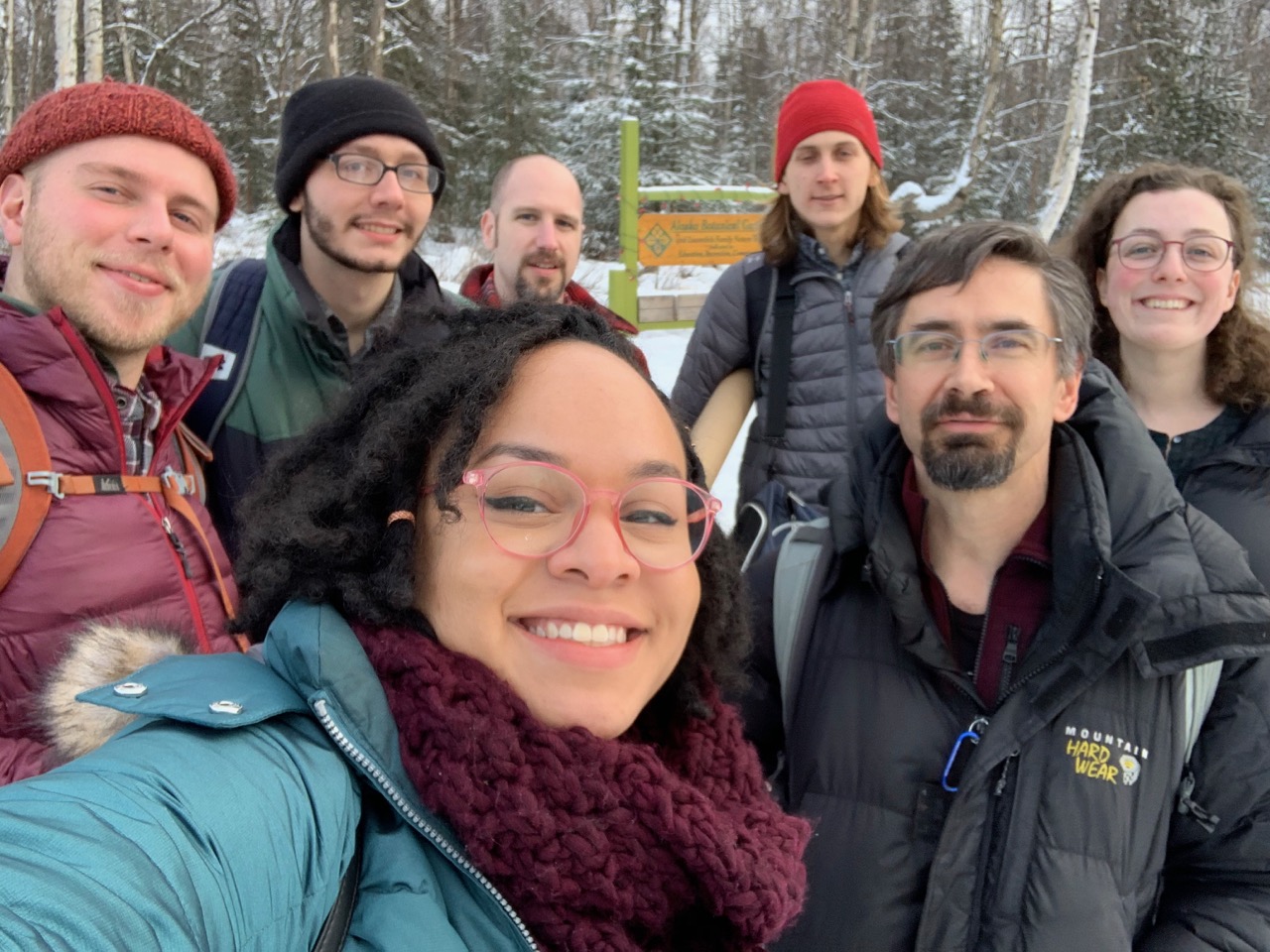 Interior Ecosystem: Wild, Living, Arthropod Biodiversity in the University of Alaska
Museum
Interior Ecosystem: Wild, Living, Arthropod Biodiversity in the University of Alaska
Museum
Kyle Callegari
Mentor - Derek Sikes, UA Museum of the North
Human-made habitats have rapidly expanded throughout the globe in an extremely short
period, permitting a vast network of microbiomes representing a completely novel habitat
(Bertone et al., 2016). Humans have been building houses for about 20,000 years but
within the last 200 years modern adaptations to the indoor environment including advancements
in plumbing, air conditioning, and new standards in ventilation have led to ubiquity
in modern buildings (Martin et al., 2015). There can be regional variation in the
habitat as well as regional diversity in the arthropods that occupy these indoor environments,
and the life history and distribution patterns of arthropod communities of these indoor
environments are largely understudied (Leong et al., 2017). Indoor arthropod community
reflects a spectrum of indoor association, from trapped outsiders (transience), to
arthropods that can establish breeding populations inside (synanthropes). Synanthropic
arthropods may have life history characteristics that have been beneficial in evolving
in association with humans. Characteristics could include prior cave-dwelling life
history, eating decaying organic matter like skin and hair (detritovores), and feeding
on mold (mycophagous) (Balvín et al., 2012). Synanthtopic arthropods can be an issue
for museums curators working to maintain their collections, because many of their
specimen and artifacts are viable food sources for synanthropes. Better understanding
pest arthropods and their distribution in a museum setting could be applicable knowledge
for these curators. In this study specimens were opportunistically collected alive
by museum staff using sticky traps and by hand, inside the University of Alaska Museum
in Fairbanks, Alaska between 2001 –2019. A minimum of 73 arthropod species in 44 families
and 12 orders have been documented alive inside the museum over eighteen years. Beetles,
spiders, and booklice represented 80% of the total arthropod abundance within these
eighteen years. Booklice abundance was far greater than comparable studies (Turner,
1998) (Bertone et al., 2016), and this is likely due to differences in collection
methods. The feeding ecology for each collected specimen was categorized by diet type
and further analyzed. Synanthropic arthropods found within the museum were primarily
fungivores and detritivores. Seasonally abundant arthropod, an indoor association
category that represented arthropods occasionally collected within the museum, were
primarily predators and omnivores. Transients were primarily predators and had the
greatest diet diversity and species diversity. Arthropods of each indoor association
category were most frequently captured in months that enforce their categorization
in a boreal ecosystem. Synathropes had the highest capture rate in January, seasonally
abundant arthropods had the highest capture rate in September, and transients had
the highest capture rate in July. This long-term study advanced our understanding
of indoor arthropods associated with the Museum of the North, and we expect the findings
to build in years to come. This study also contributes findings to an understudied
system that deserves more attention.
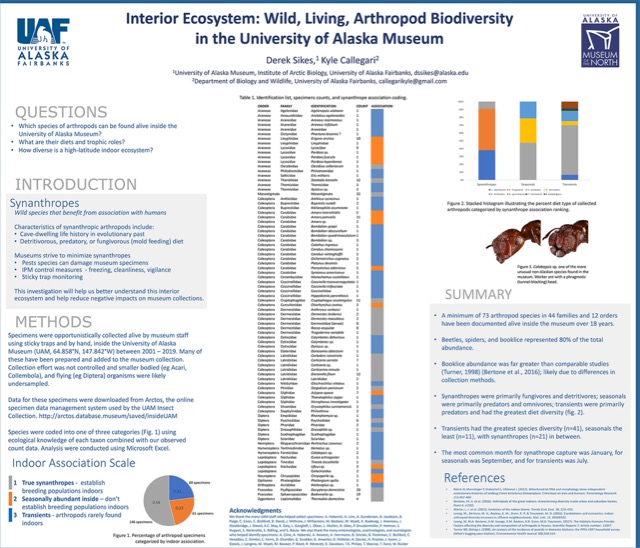
DNA repair dynamics in colon adenocarcinoma cell lines
Tristan O'Donohue
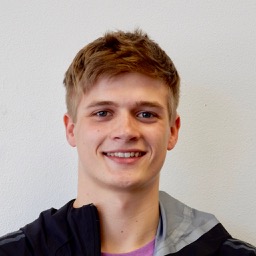
Mentor - Andrej Podlutsky
This project is a continuation of an established analysis on the effects that UV-C radiation has on immortal cancer cells. This project is significant because very little prior research and analysis has been afforded to UV-C exposure in of immortal cancer cell lines, meaning our understanding of variations in nucleotide excision repair between cell lines is limited when looking for how DNA repair is affected. This research will be used to establish a database in the future with the focus of storing relevant data of how numerous cancer cell lines respond to UV-C and X-ray radiation, with the goal of furthering the overall understanding of the dynamics at play regarding DNA repair in cancer cells. My involvement in this project has been through working with two colon adenocarcinoma cell lines, HT-29 and HCT-116, that I have been responsible for growing under uniform condition in cell culture. I have been running UV-C radiation experiments using the comet assay protocol. With the comet assay experiment and follow up analysis I will be able to determine how well the DNA repair machinery in the adenocarcinoma cell lines respond after exposure to UV-C radiation.
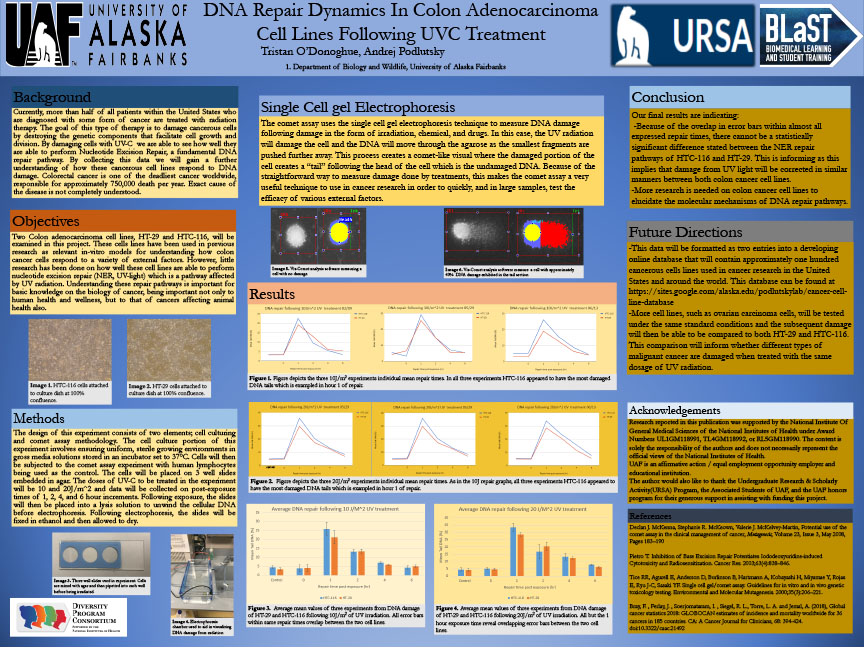
Effects of temperature and climate change on shedding rates of Trichobilharzia alaskensis
Burgenne Illingworth and Justin Bevis
Mentor - Don Larson
Our group took part in researching how various temperature changes affect the shedding
rates of the cercariae of the Trichobilharzia alaskensis parasite. This research took
place in interior Alaska, in the Tanana Lakes. We used a variety of snails collected
from the lakes as the parasite hosts. There are a variety of parasites these snails
had but the ones we wanted were the T. alaskensis parasite, more commonly known as
the Swimmer's Itch parasite.
We collected thousands of snails and created a stimulus to allow for the shedding
of the parasites to occur. We then placed the individual parasites on. slide under
the microscope, and using a dichotomous key, identified what, if any, snails were
infected with our target parasite. When we found ones that were infected with T. alaskensis
we stored them in a cold room and then created a testing plan. We used the plan to
thoroughly test and observe these snails when we submerged them in cryo baths of controlled
temperatures. We placed them in baths ranging from 2 to 10º C to determine when the
average snail stopped shedding the parasites.
This research allows us to examine how temperatures that change, and ultimately how
climate change, affects not only the parasites life cycle and population; but their
entire ecosystems as well.Of all the various climates that climate change is affecting,
it is taking the largest toll on the Arctic. Unfortunately, there is only a small
pool of data available regarding the issue. Climate change and warming will affect
animals, people, and the environment. Warming is already starting to heavily affect
the parasites and their relationships with their hosts (Lafferty et al., 2006).
Our mission in for our research was not only to learn more about the parasite, their
hosts and their environments. But also to help to create a more sound and complete
source of information on how climate change could, and already is dramatically affecting
the arctic and the organisms and ecosystems within.
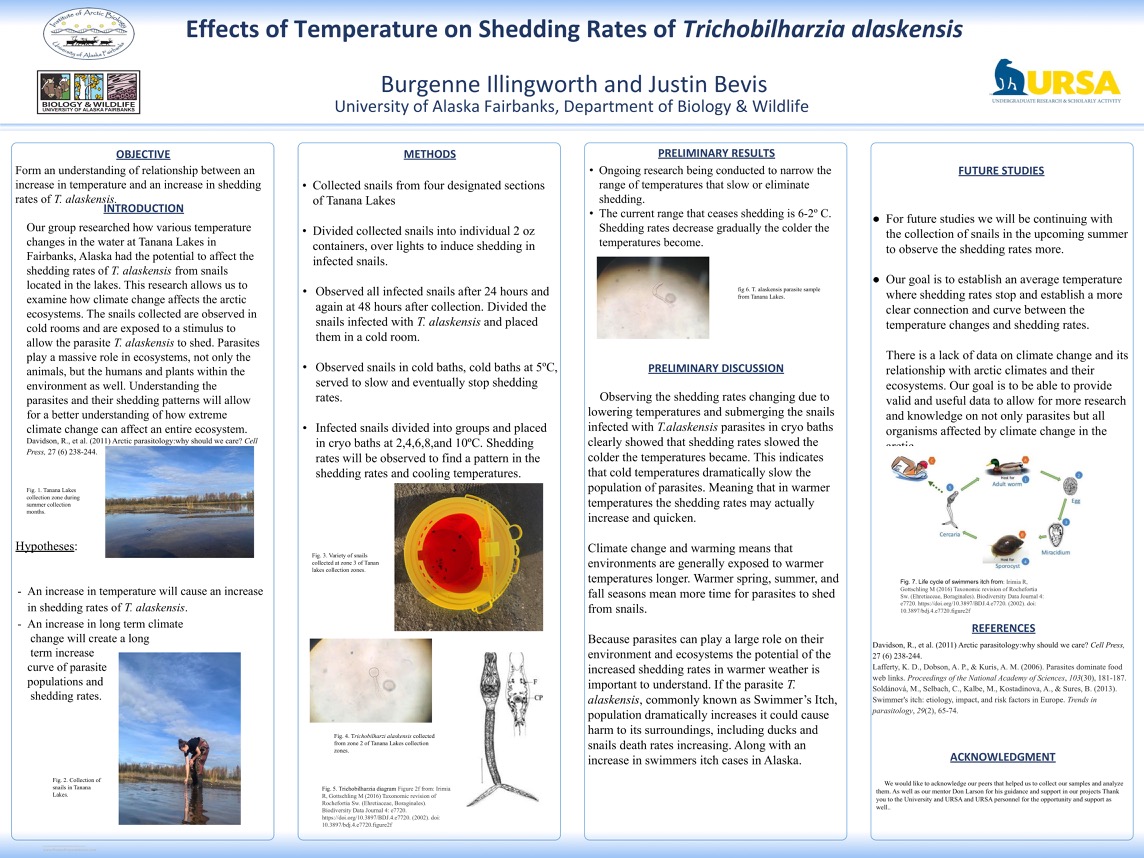
Translating Hibernation for Neurocritical Care

DeAnna Lowden
Mentor - Kelly Drew
When arctic ground squirrels are hibernating they are able to conserve a lot of energy and drop their core body temperature into below freezing limits. Don’t you think this would be beneficial for patients who need therapeutic hypothermia for their treatment plan? Well, we are mimicking this response with the use of developmental drugs to potentially treat people who suffer from cardiac arrest to improve their survival rates. This process is essential for humans that experience cardiac arrest because the standard of care is to immediately cool these individuals by inducing them into a therapeutic hypothermia, to help protect the brain from further damage. About 10% of cardiac arrest patients walk away from it, with no neurological deficits. This is a very low statistic on a wider scale. The standard of care treatment is not as good as it could be because of the body's cold defense response and the amount of stress it puts on the body, making the organs work harder. In addition, this standard of care is not accessible to all neurocritical care, like strokes, because of the cold defense response symptoms. We would like to change that. Our goal is to develop or discover a combination of novel drugs to allow the body to drop their body temperature without cold defense response mechanisms interfering with their survival success rates, and decrease hospital stay and neurological deficits. This novel drug formulation is based solely on how we can mimic the response that arctic ground squirrels go through when they are hibernating. Based on the ground squirrel work, we identified the mechanism and a drug sufficient to induce hibernation, N6 cyclohexyladenosine or CHA. We will be carrying out this experiment using rats and watching how they react to the novel drugs, a mixture of CHA and 8-SPT, a drug combined with CHA to protect against cardiovascular side effects caused by the CHA, compared to the control of the standard of care, which is a combination of meperidine and buspirone. If they survive past a week, we would then measure their neurological state to see whether or not the standard of care or this drug has better success. In addition, we are testing to see if the animals could be cooled to 33-36°C, without the medical complications we see cooling below the currently recommended 36°C. By translating this knowledge into evidence we could use for neurocritical care, it would allow for a more controlled state for the body to heal, and the survival outcomes would be much better. Patients would be able to get the adequate treatment their body needs to recover, not just what they can handle because of the cold response system. We hypothesize that the novel drug will mimic the hibernation mechanism and potentially allow for patients, in need of neurocritical care, to live a longer, better quality life than what is expected today, increasing the survival rates to above the 10% for cardiac arrest.
Unnatural Stereoisomers of Sphingosine Inhibit Sphingosine Kinase as Detected and Quantified by Capillary Electrophoresis and Fluorescence with β-Cyclodextrin
Alexandra Keller
Mentor - Tom Green
Sphingosine-1-phosphate (S1P) is an important lipid in cell membranes that aid in
cellular communication and function. Sphingosine kinase (SphK) phosphorylates sphingosine
to S1P. Both sphingosine and sphingosine-1-phosphate are diastereomers with a total
of four potential stereoisomers. Natural forms of sphingosine are heavily controlled,
and reactions are stereospecific. This leads to only one form of sphingosine and S1P
being found in nature. Sphingosine and its metabolites synthesized in lab are often
racemic mixtures, yet unnatural stereoisomers of sphingosine could have inhibitor
competition with SphK. Capillary electrophoresis and fluorescence detector are highly
sensitive instruments that yield great resolution when combined with a stereo selector
such as cyclodextrin (CD). The cyclodextrin used was 2,3-dimethyl-6-sulfobutyl-β-CD
(DMSB-β-CD), a CD that contains an extended nonpolar cavity down from the 7 sulfobutylated
carbon rings. Sphingosine was derivatized by naphthalene-2,3-dicarboxaldehyde (NDA)
to yield a fluorescence molecule. CE-LIF was used with the CD to determine appropriate
methods of sphingosine enantiomer separation for future analysis of sphingosine.
We determined that due to the long carbon chain in sphingosine and the polar head
group, sphingosine forms micelles. This correlates to poor separation of sphingosine
enantiomers using traditional CE-LIF techniques. We reevaluated our methods of separation
and determined that it is best to use micellar electrokinetic chromatography. This
is a form of capillary electrophoresis in which surfactants are added. These surfactants
form micelles due to hydrophilic and hydrophobic ends. This technique is great to
solubilize analytes that would have otherwise been insoluble in water, as sphingosine
is believed to be. The added addition of CDs can enantiomerically select using MECK,
however there are known natural surfactants, such as certain bile salts, that also
can act as chiral separators. Our initial hypothesis of how to separate sphingosine
enantiomers was inefficient and yielded poor results. The future for sphingosine analysis
is to use MECK, yet more research needs to be done to determine the most efficient
procedure, such as chiral selector surfactants versus cyclodextrins.
Thermokarst
Abby Amick
Mentor - Jennifer Guerard
This project examined the composition of organic matter in thermokarst and non-thermokarst lakes in the Goldstream Valley near Fairbanks. Thermokarst lakes are lakes that result from the thawing of underlying permafrost. It is important to understand the composition of permafrost and non-permafrost lakes in order to gain knowledge of the impact of permafrost thaw and how lakes’ ecosystems might be altered due to climate change. By analyzing water samples from soil beneath the bed of selected lakes and distinguishing permafrost and non-permafrost lakes, this study hopes to aid future researchers in predicting how specific molecules in these lakes will react to changes in temperature. This project focused on the molecular composition of organic matter in a permafrost lake near Fairbanks, AK. Pore water samples (water contained in the pores of soil from a drilled core going 90cm or deeper past the bottom of the lake) were extracted from a 20 meter core of soil sampled from the bottom of the permafrost lake. Pore water was then analyzed by nuclear magnetic resonance (NMR) spectroscopy, allowing identification of molecular groups in the samples. NMR spectra for varying depths were integrated to find the percent composition of four main groups of organic molecules: aromatics, carbohydrates and peptides, carboxyl rich alicyclic molecules, and material derived from linear terpenoids. These results were compared to past research on non-permafrost and permafrost lakes in the Goldstream Valley to provide a comprehensive look at the trends in the organic composition of lakes with differing levels of underlain permafrost.
Due to the Covid-19 pandemic and closure of UAF laboratories, the data related to pH, conductivity, total dissolved iron, absorbance, and fluorescence was unavailable for comparison. The analysis of this additional data could help to give a more complete understanding of thermokarst lake composition for the lakes in the Goldstream Valley near Fairbanks, AK.
Temporal InSAR Coherence Analysis at Makushin and Cleveland Volcanoes: Toward Proactive InSAR Monitoring of Volcanic Surface Deformation in the Aleutians
Rowan Biessel
Mentor - Franz Meyer
Volcano monitoring is an important task for identifying imminent eruptions and mitigating the risk posed by such events. Geodetic measurements of ground surface movement is one such method, providing insights into the character and trends of subsurface magma flux. Traditionally done with GPS, the paradigm is shifting to utilize InSAR, a microwave remote sensing method with large spatial coverage yet numerous sources of uncertainty. One such source, noise or decorrelation, is difficult to model how it contributes to the phase difference and subsequent deformation calculation. The estimated coherence of a pixel is related to its uncertainty and can be used as a data quality assessment. Estimations of interferogram coherence will optimize unsupervised monitoring of volcanoes by ignoring image pairs that will not provide viable data. Using the InSAR Scientific Computing Environment, this study performs a two-year coherence analysis of Cleveland Volcano, processing 1431 interferograms with coherence maps, and a one-year coherence analysis of Makushin Volcano, processing 254 such image pairs. Interferograms of Cleveland volcano generally had a higher temporal coherence than those at Makushin. Coherence from interferograms formed from images acquired in the winter only over Cleveland volcano also exhibited a sinusoidal pattern not exhibited in any other sets. Additionally, this set showed a more gradual coherence decay with time when compared to other sets. In regard to both volcanoes’ spatial distribution of coherence, the high elevation summits were generally below a coherence of 0.3 even with the shortest temporal baselines. With baselines greater than 12 days, only the northwestern flank of Makushin remains viable. This decorrelation close to the eruptive centers of the volcanoes presents a challenge since these are the most likely areas to exhibit deformation. With the eventual goal of coming up with a predictive coherence model for the Aleutian volcanoes, additional regions must be investigated including an analysis with respect to landcover type as well as temporal baseline. Such further work on this project will incorporate pixel wise statistical analysis with respect to landcover, time of year, as well as temporal baseline with the possible aid of machine learning in order to predict the coherence of every pixel in a proposed interferogram. Such an algorithm could be implemented into the Alaska Satellite Facility’s interferometry baseline tool as SAR processing systems such the Jet Propulsion Laboratory’s ARIA project.
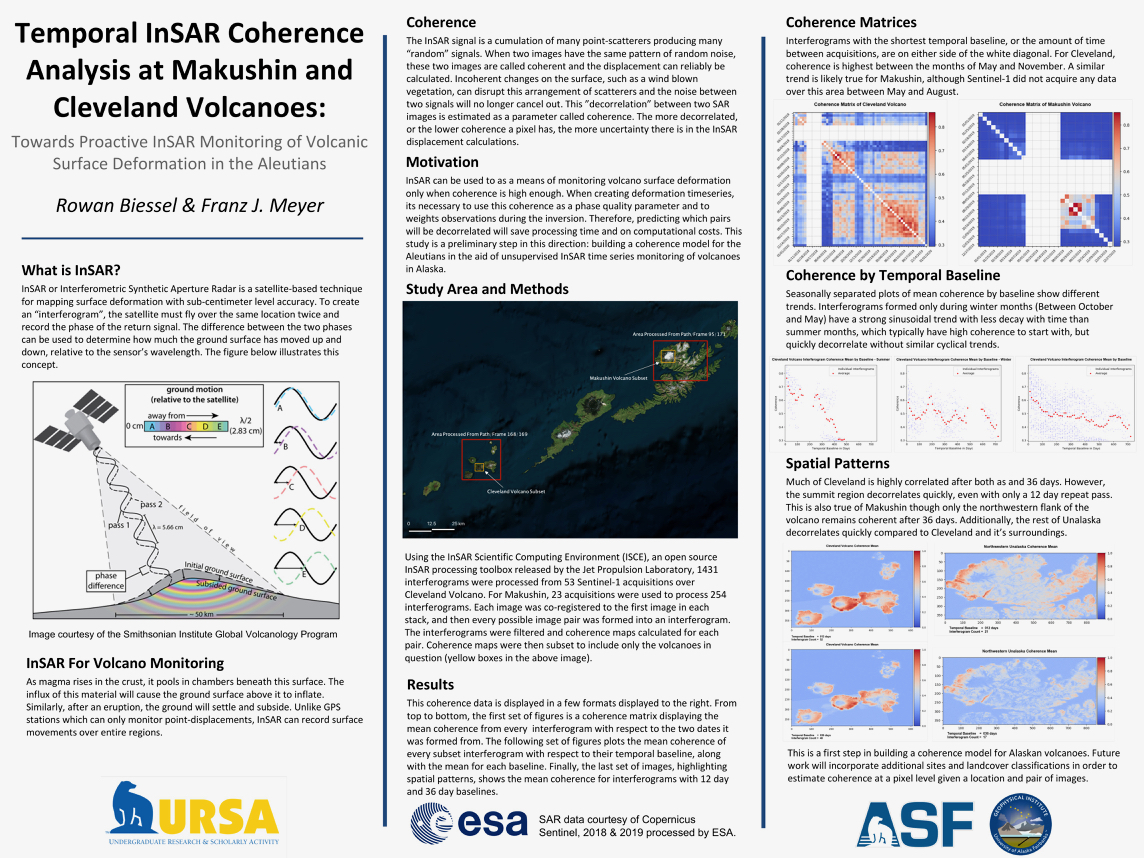
Creating a VR model of the permafrost tunnel
Conner Truskowski
Mentor - Margaret Rudolf
A virtual reality (VR) model of the CRREL Permafrost Tunnel was created as an undergraduate student project to help educate the public and students on permafrost and climate change. The Permafrost Tunnel, located 16 km north of Fairbanks, Alaska, is a series of tunnels dug into the permafrost owned by the U.S. Army Cold Regions Research and Engineering Laboratory (CRREL). In this facility, research on climate, geology, paleontology, engineering, and permafrost is developed. The Tunnel VR was done as part of a larger NSF project, Hot Times in Cold Places, which has traveled to 40 rural Alaskan villages to engage in discussions of permafrost and climate change and has developed a permafrost teaching kit with 3D printable models. The Tunnel VR program was made using a 360-degree GoPro Fusion camera, Agisoft Metashape, and the Unity game engine. With limited access to the real Permafrost Tunnel, the VR tour allows a far wider audience to engage in learning about permafrost in an immersive and interactive way. Users can see the variety of permafrost features as well as learn about climate change while experiencing the “feel” of this unique underground laboratory.
Lake Atna Megaflood: Megafraud?
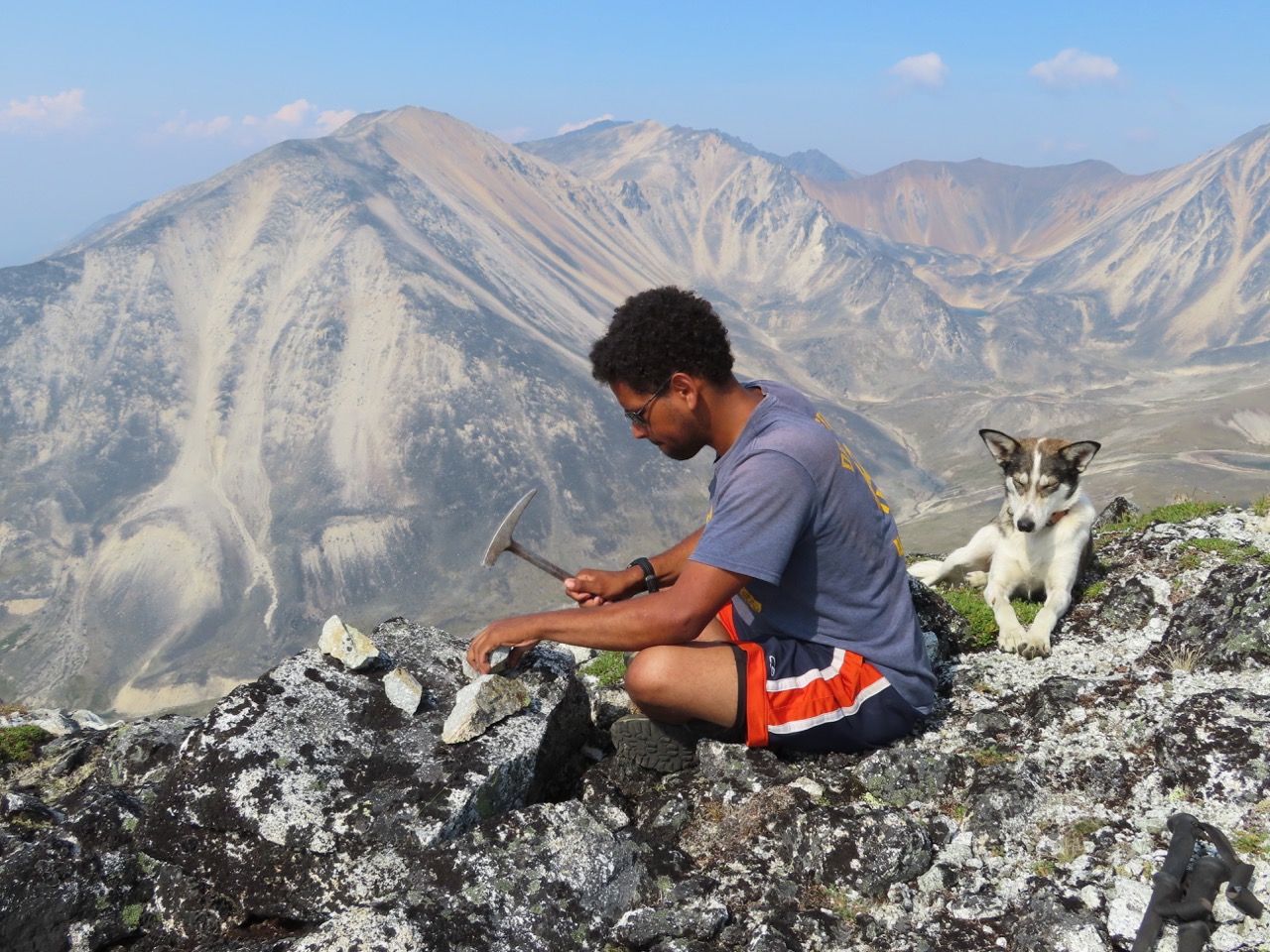
Jalen Cox
Mentor - Jeff Benowitz
This project examined the previously proposed possibility of a Lake Atna glacial outburst
megaflood flowing through the Matanuska Valley from the Copper Basin ~20,000 years
ago. My mentor, Jeff Benowitz, and I began the project by collecting sediment samples
near Glen Allen from a Lake Atna outcrop that were used as our controls. We then collected
sediment samples down the Matanuska valley from its head till its junction with the
Susitna valley to be dated using a combination of U-Pb detrital zircons and 40Ar/39Ar
dating. Using the magmatic ages determined by these geochronological methods, we aimed
to test if sediments originating from Lake Atna in the Copper Valley were transported
down the Matanuska valley during a megaflood. This application is referred to as source
to sink province geochronology. Due to both mechanical difficulties and the COVID-19
pandemic we were only able to obtain U-Pb detrital zircon dates for our samples to
date, but have prepared the samples for 40Ar/39Ar dating. I traveled to the University
of Arizona with Sean Regan and assisted with dating my samples using the ICP-MS U-Pb
detrital zircon method.
Besides Lake Atna, our control, the two most important locations sampled were Tahneta
pass at the head of the Matanuska Valley (T-Pass), and adjacent to the Gorilla fireworks
stand in Huston, Alaska (East Gorilla). Based on the U-Pb zircon data and statistical
analysis, we found that the zircon age signature of sediments from the known Lake
Atna site bears little resemblance to the ages obtained from East Gorilla and T-Pass.
The Lake Atna sediments were very abundant in zircons aged 0-30 Ma (10%, N=10), 130-150
Ma (23%, N=23), and zircons 300-320 Ma (14%, N=14). By comparison, East Gorilla contained
only 2 zircon grains that were 130-150 Ma (2%) and both T-Pass and East Gorilla had
zero zircon grains that were 0-30 Ma and 300-320 Ma. Most important among these are
the zircons aged 0-30 Ma. This age range is associated with Wrangell arc volcanism,
a key piece of our hypothesis. Lake Atna site is located adjacent to this volcano
field. If a Lake Atna megaflood had indeed come through the Matanuska valley, we would
expect to see traces of these 0-30 Ma sediments all the way down the valley. Based
on the U-Pb detrital zircon dates and the lack of these key marker sediments in the
Matanuska deposits we infer that a catastrophic megaflood did not flow through the
Matanuska valley ~20,000 years ago. An alternative hypothesis that has been proposed
is that the “megaflood’ sediment deposits in the Matanuska valley have a local glacial
origin. Our preliminary data supports this hypothesis given the U-Pb zircon age signatures
of the T-Pass and East Gorilla samples resemble the detrital zircon signature of the
modern Matanuska River. When the 40Ar/39Ar analysis is done, we will incorporate the
results in our interpretation and write up study for publication in a peer review
journal.
Dating dikes of southern Alaska to constrain the timing of folding and faulting
Lauren Livers
Mentor - Elisabeth Nadin
In geology, igneous dikes place time constraints on the rock units they cut across and indicate extensional stress. In the past few years, UAF field camp students have started mapping dikes in the Talkeetna Mountains, but no one has analysed their age or geochemical composition. I used the rock saw to cut samples of two dikes that cross-cut the UAF geology field camp site of Limestone Gap, and then mailed them to labs for age and geochemistry analyses. These dikes are important for understanding the timing of deposition and deformation in the area, since they cut across sediments that are around 100 million years old. They also document the stress at the time they were emplaced. Additionally, these dikes may belong to a family of igneous bodies, called the Sanak-Baranof belt, that were emplaced along the southern margin of Alaska during subduction of an oceanic spreading ridge. This belt appears across all of southern Alaska along a ~2,000 km stretch from Sanak Island in the west to Baranof Island in the east. It is suggested that this happened about 55 million years ago. Ar/Ar dating was used to determine whether the dikes were emplaced shortly after the sediments they cut, or much more recently, possibly as part of the Sanak-Baranof belt. The age and geochemistry data from the samples has not been sent to me yet; once I have the data I will be able to understand when deformation occurred in the basin. Their compositions, which I will determine using XRay Fluorescence once UAF is open again to students, will tell me the environment in which they formed and if they match the igneous rocks of the Sanak-Baranof belt. If they do not match well in composition or age range, then these dikes are instead associated with local deformation in the field-camp area. The sample data that I will receive in the next few weeks, plus the knowledge I have gathered by reading relevant papers on the area, will allow me to compile a comprehensive understanding of the deformation of Limestone Gap. This information will help geologists better understand the tectonic development of the Talkeetna Mountain.
Winter Snow Contamination in Fairbanks within Different Air Qualities
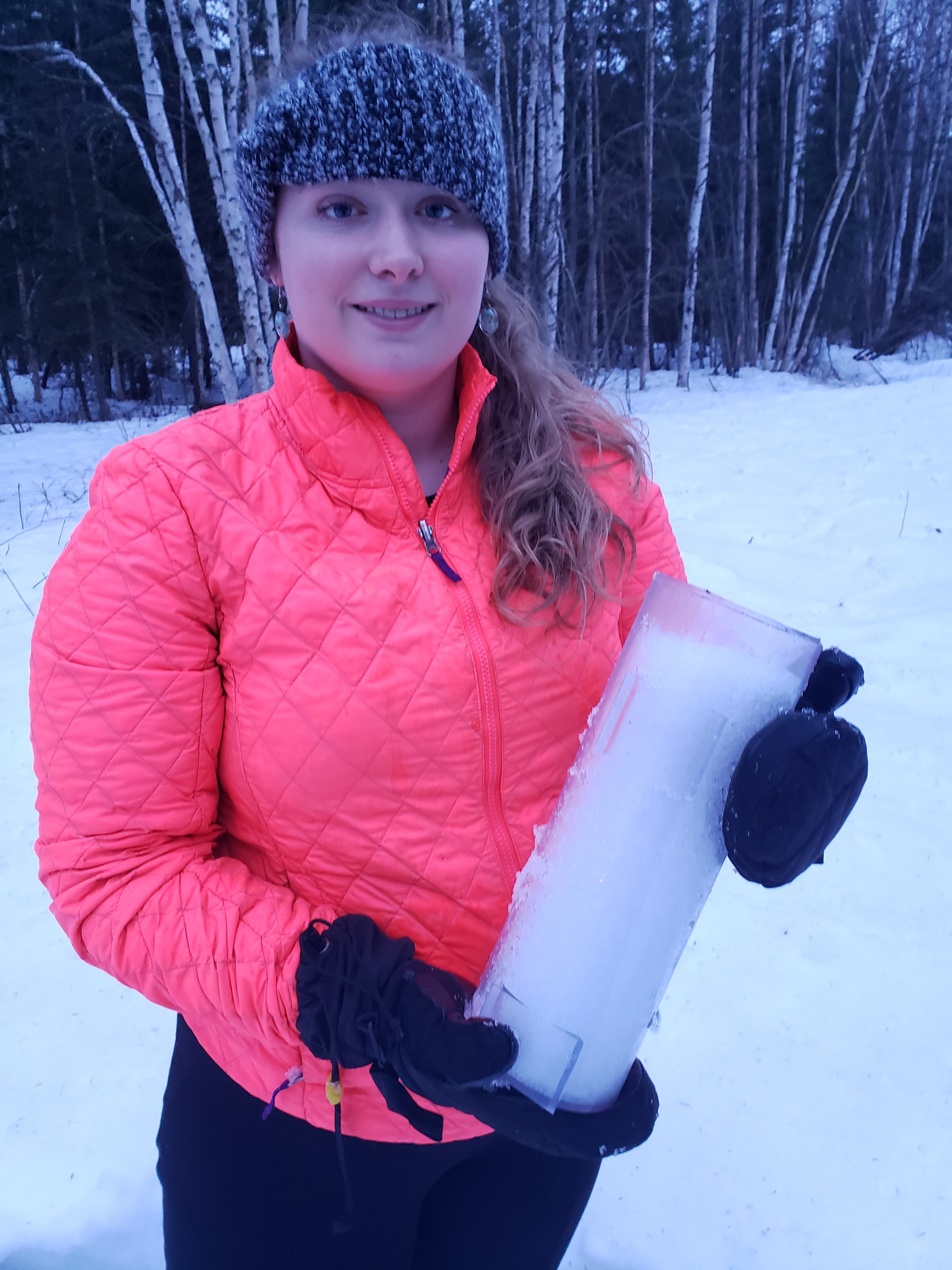
Sierra Von Hafften
Mentor - Christi Buffington
The Fairbanks area is known for its poor air quality, often exceeding the EPA standards during the winter months of the year, which can lead to health problems. This poor air quality may also affect the pH of the precipitation intern affecting the water quality. By looking at how the air quality affects the precipitation of the Fairbanks area and testing many different sites around the Fairbanks area that align with air quality sensors, I was able to gain a better understanding of any potential correlation with air quality and the quality of the precipitation. By choosing 14 different sample sites around Fairbanks and the surrounding areas that have different air quality readings and at roughly the same time for consistency, I was able to identify differences in the contaminates that were contained within the precipitation and which had been transferred through the snow forming process that occurs at relatively high elevation. Each site will have a recorded ground temperature, air temperature, cloud cover, snow depth measurements, snow sample, air quality sample, any structures in the area and any identifiable vegetation. Fairbanks, often being found to be one of the cities with the worst air pollution over the course of the year, I believe could use the information collected in this study to determine the best course of action within their pollution minimization plans that have been developed over the course of the past several years. By having a better understanding of the effects that the distributions of the pollution has on the precipitation, more localized plans of actions can be formulated as a response. In order to further educate the public about the potential harm that can occur due to this pollution, I plan to use my data to design a flyer and presentation that will be made publicly available through different channels.
Identification of Pollutant concentration within the Chena River
Gabriel Madore
Mentor - Chris Maio
The water quality of Alaska cities has a long and rich history of being contaminated
by human development and activities that occur within the immediate and surrounding
areas. The city of North Pole has faced a polluted water supply crisis as recently
as 2009, while many of the residents who reside in the Fairbanks North Star Borough
as a
whole can cite the city website for six contaminated groundwater zones. By sampling
a variety of locations both up and downriver of Fairbanks and performing tests for
PFAs, lead. Manganese, arsenic, chromium, cadmium,mercury and nitrate, I will be able
to determine the distribution of where contaminants are introduced into the river
and general areas that are problematic. Upon receiving and reviewing the results,
a report will be formatted to display and explain the contamination levels of the
Chena river and be presented to the Fairbanks North Star Borough Assembly members,
a copy is also to be sent to both the Mayor for the city of Fairbanks and the Mayor
for the city of North Pole. As the Department of Natural Resources (DNR) website does
not list a study being completed on the waters of the Chena river since 1988 and no
study being completed on the quality of groundwater since 1995, the importance of
conducting a study to fill the need of having records is quite understandable, especially
considering the potential pollutants that are contained in the river. Two ongoing
lawsuits were filed during 2019 in relation to the unprecedented groundwater contamination
that occurred in both North Pole and Fairbanks, one against the 3M company and Tyco
Fire Products, while the other is against Williams Alaska Petroleum.The situations
are unrelated, however the outcome of both are the same, the waters became contaminated
and are now unsuitable for human consumption or animal habitation.
Clam predation patterns as a way of understanding sea star wasting disease
Tibor Dorsaz
Mentor - Brenda Konar
Each year, the Naval Academy Science and Engineering Conference brings undergraduate students together from across the United States to discuss varying scientific topics. This year’s focus is on marine exploration, conservation, and extreme events. My research on the ecological impacts of sea star wasting disease aligns perfectly with this year’s theme, as wasting disease is a consequence of the extreme heat wave that affected the North Pacific Ocean.
As a previously URSA funded student, I researched the impacts of the sea star wasting disease and the loss of a keystone predator. To do so, I studied the predation patterns of sea otters and sea stars on clams. I compared the proportions of clams eaten by sea otters and by sea stars before and during the disease’s occurrence in Kachemak Bay, Alaska. Through this project, I was able to gain experience working in the field as a scientific diver and processing samples. I was also able to carry out a study from beginning to end, and learned of the challenges that accompany preforming research.
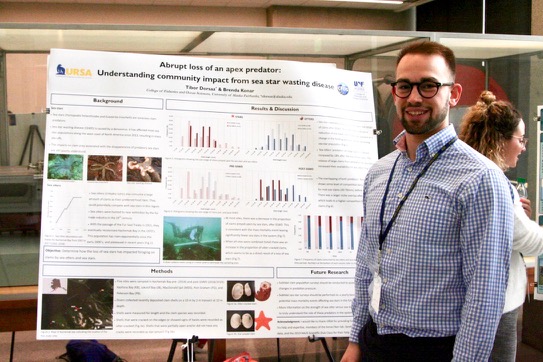
Reclaiming Traditional Names to Promote Dine' (Navajo) Language and Culture
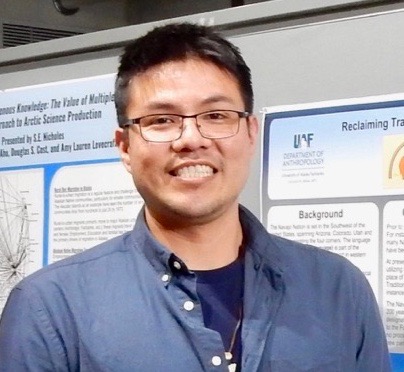
Kendrick McCabe
Mentor - Elaine Drew
The work I have completed for my travel involved attending the Navajo Nation Human Resources and Review Board Bi-Annual Conference. The conference involved the presentation of my project in poster format along with other projects being presented over the course of two days. In those two days between every meeting I stood by my poster presentation and explained my research project to members of other Universities. The Projects presented were interconnected and overlapped in various conference rooms. My project was noticed by a few professors and attendees from other universities for its cultural significance and contribution to language revitalization. Questions regarding my project included: What are you doing this for? What have you found? How did you come up with this idea? What do you plan to do next? The project found a significant positive feedback in the application notion of contemporary language use. Very significant discussion over the continued use of these methods in various other reservations were very helpful among the academics and researchers. The final day of the conference found a few discussions into others name usage as well as reflection of Navajo language use among young Navajo children. Interestingly enough, elders self reflection of their own Navajo names sparked conversation of contemporary use among a select few. Further inquiry of results were asked of this researcher by the members of the board to which positive feedback was found. Further investigation of name usage in churches were discussed and produced results that require a new project protocol involving past name documents among Catholic churches on the reservation. These documents in conjunction with this current project holds significant applications to the revitalization of the language. The presentation of this project produced positive feedback as we as further community inquiry into the continued investigation and work of this researcher.
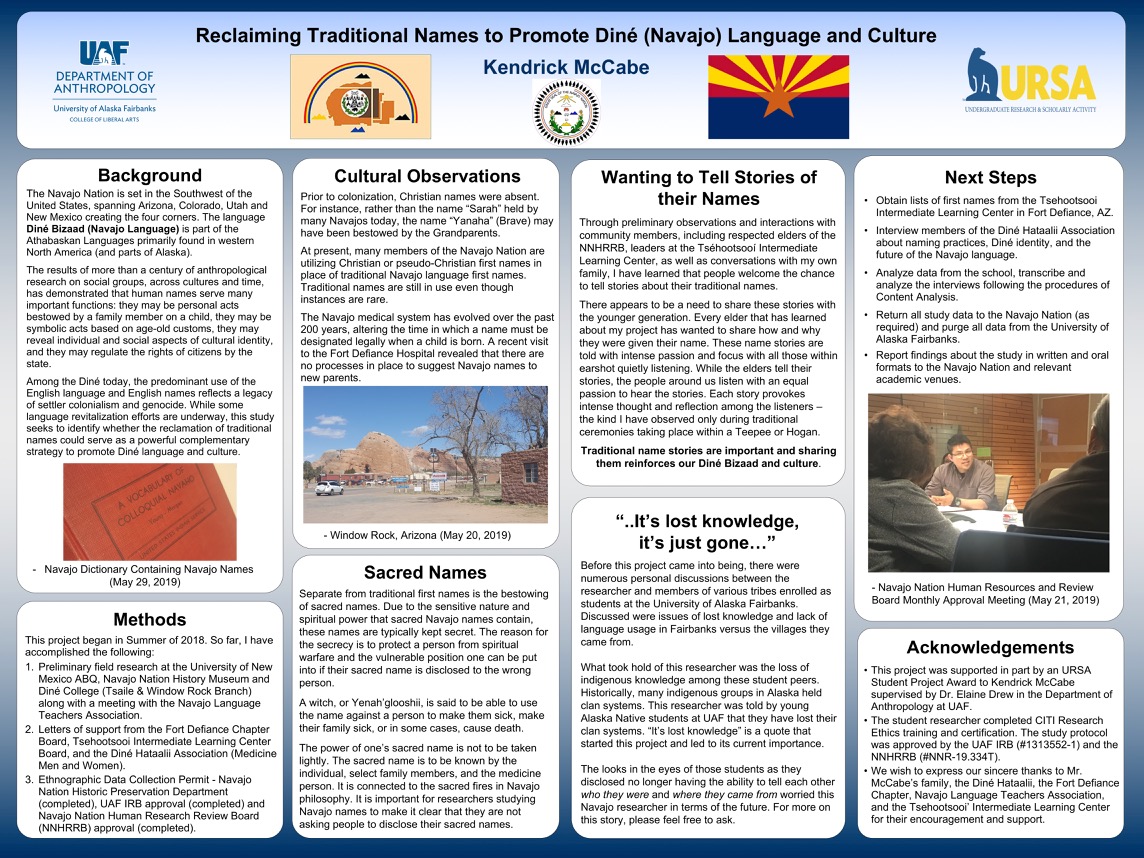
Taphonomic Analysis of Caribou from the Croxton Site (Tukuto Lake, Alaska)
Taylor Vollman
Mentor - Jamie Clark
This study assesses taphonomic damage to caribou bones from the Croxton site, with a goal of reconstructing both human butchery and processing behavior and the impacts of carnivores on the assemblage. The Croxton site is located in the Brooks Range and contains both Ipiutak and Denbigh occupations. The connection between Ipiutak peoples living in coastal and interior settings is not well understood. As a large interior site, Croxton has the potential to contribute to the broader understanding of this period. Croxton was excavated by field crews in the early 1980s, with some additional excavations taking place in 2000. All material has been housed at the University of Alaska Museum of the North, where much of it remains to be studied. Beginning in 2016, UAF zooarchaeology students analyzed faunal material from Level 1 of Unit 180S/88W, an Ipiutak occupation layer. For this project, caribou bones were analyzed under a microscope to record cut marks, percussion damage, carnivore damage, and acid etching. Presence/absence data was recorded along with cortical preservation. Cut marks and carnivore damage were draw onto printed templates to match their positioning on the bones as best as possible. Results were compared to other studies conducted on the Croxton fauna. This study found much higher frequencies of cut marks and carnivore damage than previous studies, which may be the result of different analytical methods (primarily the use of a microscope in this study). Drawings of the placement of cut marks were compared to ethnoarchaeological/experimental datasets to determine specific butchery processes. This analysis suggests that all stages of processing were present at Croxton, which indicates hunting took place nearby the site. Elements were grouped into body sections to see if certain areas of the body had higher frequencies of taphonomic damage. This revealed that carnivores had access to all body sections, with no indication that dogs were fed specific elements, something that has been documented in historic period sites in the Brooks Range). These results are critical to our understanding of site formation and disturbance processes at Croxton.
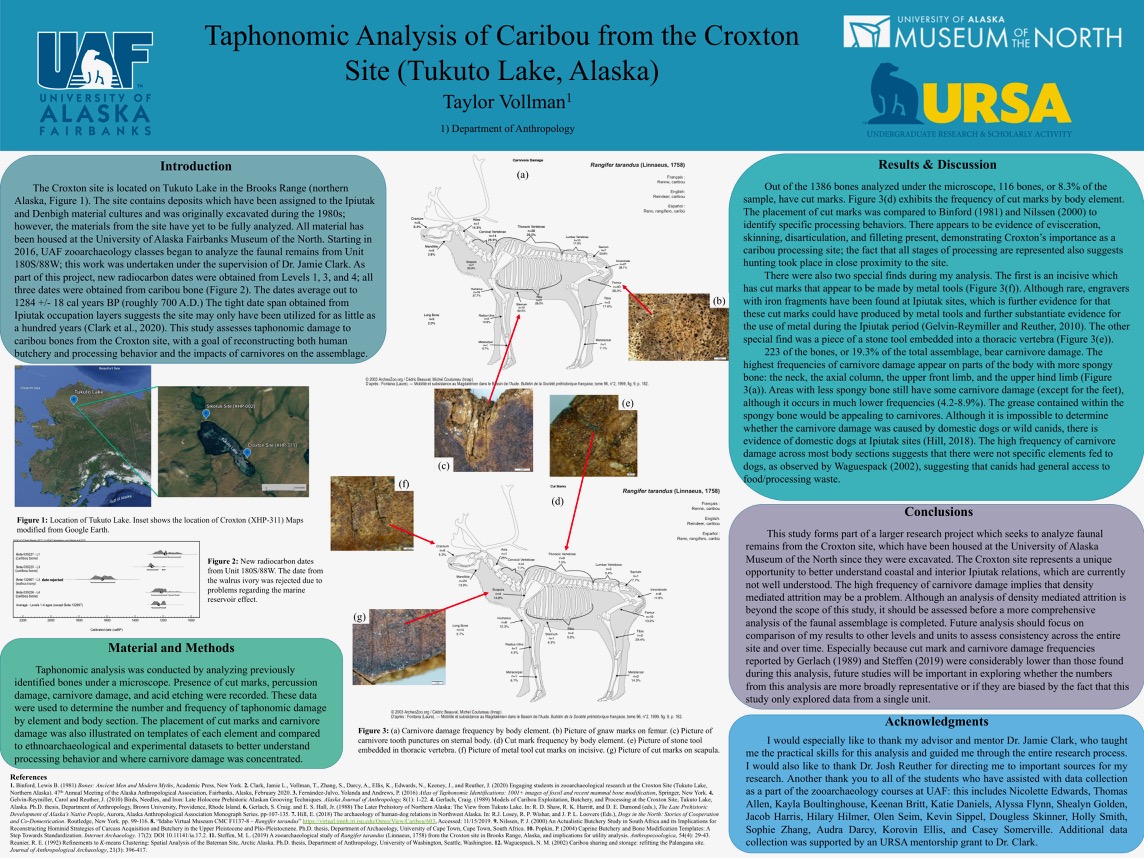
Finding Home
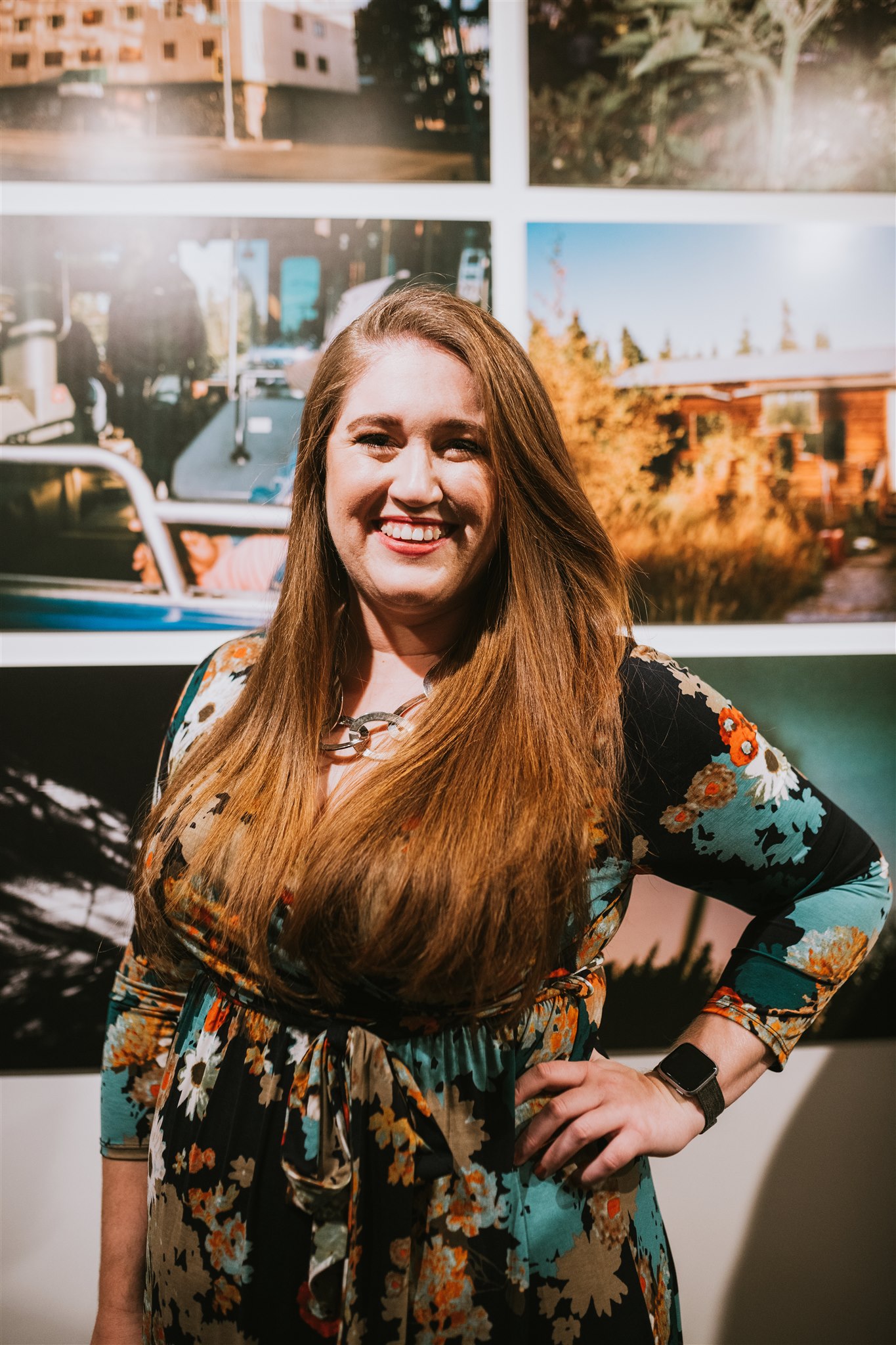
Sarah Manrqiuez
Mentor - Alex Hirsh
In Fairbanks over the last several years, I have developed 3 separate bodies of work that all speak to different elements of homelessness in Alaska. These works have been exhibited and used to raise awareness and funds for local organizations who serve our homeless populations. The first part of the work is called “My Home in my Hands”. These intimate hand portraits showcase the most prized possessions that these people have kept despite losing so much else. The second part of the work is called “Genesis”. This part of the work explores the specific challenges that our homeless population face by chronicling one person's specific story. The third part of the work is called “Through Our Eyes”. The nation wide project encourages participants to tell their own stories the way they want them presented in the world. Disposable cameras are given to local people who were experiencing homeless with one simple instruction- photograph your life. The three bodies of work all address different elements of homelessness and start to break down the complexities of the issue.
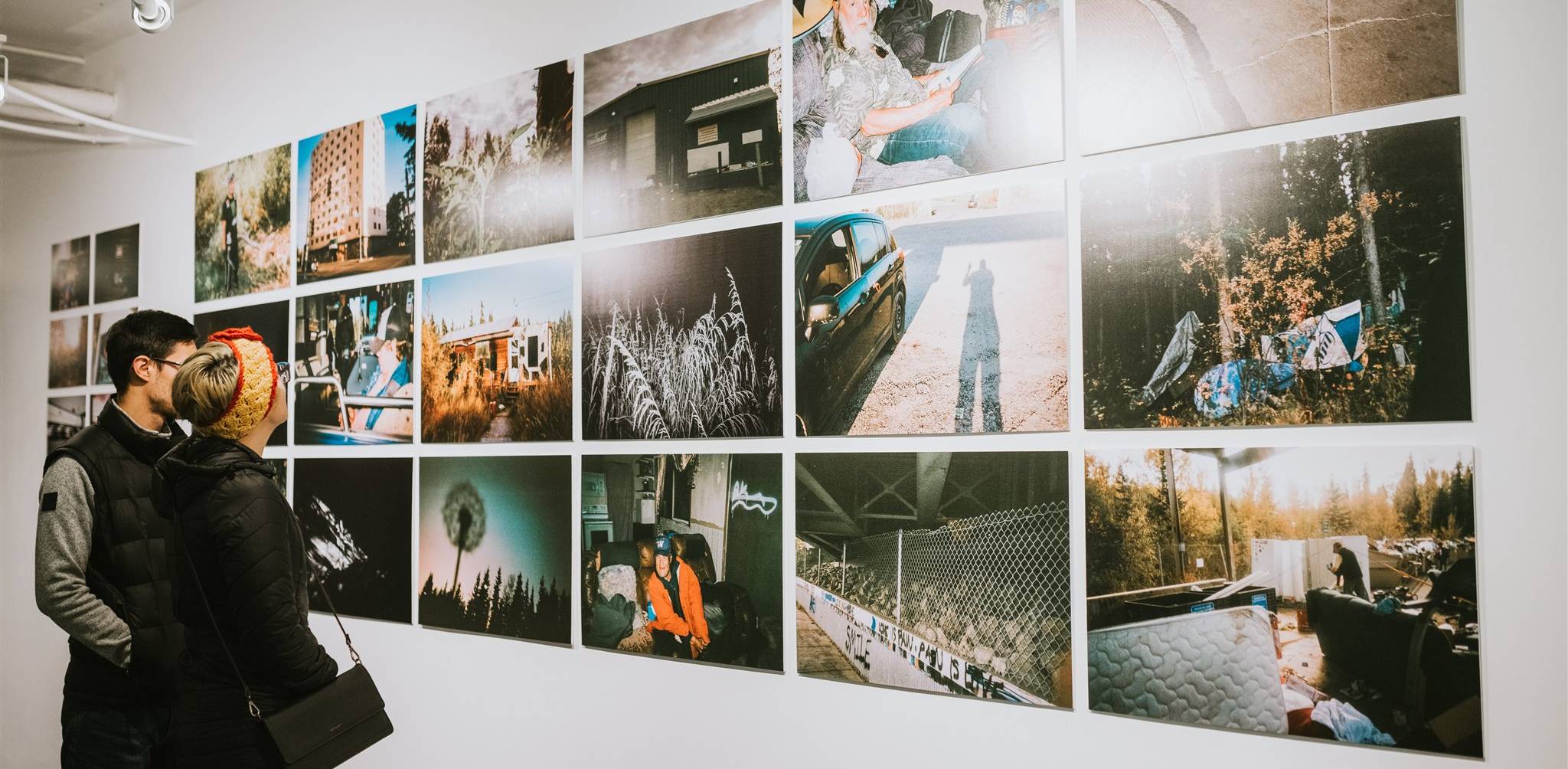
Ice Box Literary Journal
Emma Charlton, Shelby Anderson, Abby Bravo, Stanley Rogers, Annie Wenstrup, and
Hunter Young
Mentor - Joe Holt
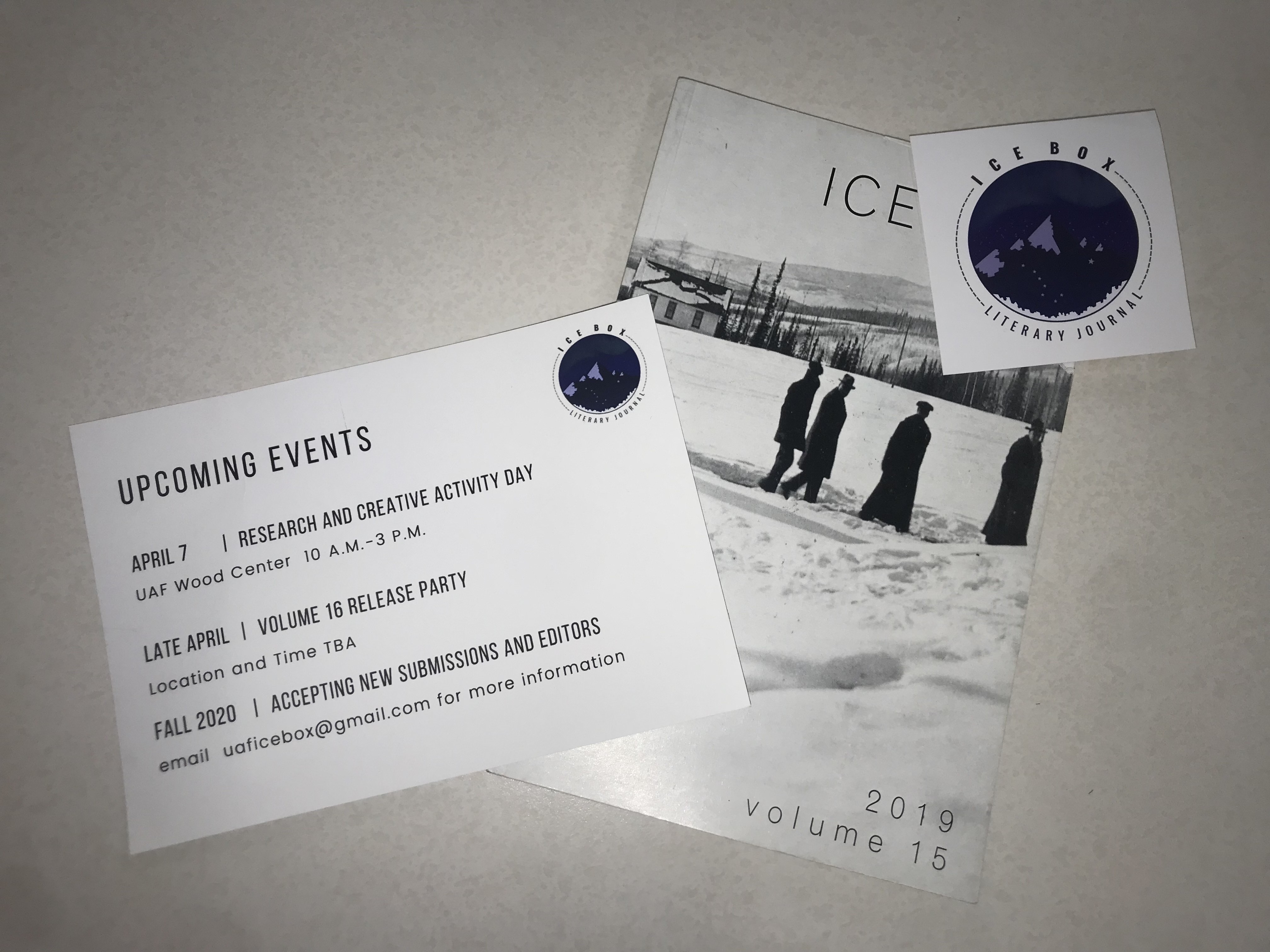
Ice Box is the literary journal for undergraduate students at the University of Alaska Fairbanks. We, as editors, spent the fall semester publicizing the project and soliciting submissions of creative work from students with fliers, tables, and other outreach. We received fiction, nonfiction, poetry, and artwork submissions from students across the university in various departments. Once submissions closed, we evaluated what to include in the publication. We will be showcasing the creative work of twenty-nine students in the Ice Box publication this spring, fifteen more than our relaunch last year. There is also a much greater variety of work. The inclusion of visual art is a new aspect of Ice Box, and there is more nonfiction than last year as well. We corresponded with student writers, edited work with them, and copyedited final pieces individually and together as a group. The design of all the journal's aspects was done in collaboration with our editors before going through the process of publication. One of our editors redesigned a logo from scratch as well as the Ice Box cover art for this issue. We were derailed, as was everyone else, by the pandemic but have adjusted around it. W e are committed to publishing this year's volume of Ice Box and we are continuing a conversation with the publisher in town that was used last year. The event planning for our release party that was started has changed to planning shipments of the journal to our student contributors, English Department faculty, other people and groups who have assisted us in some way, and the editors ourselves. We are still brainstorming and talking about alternatives for a release party including virtual or in the fall semester. The final result of Ice Box's publication is the product of hours of hard, intentional work done by dedicated students, writers, and editors.
Strategies and Tactics In Learning Network Design for Writers Inside and Out of Carceral Spaces
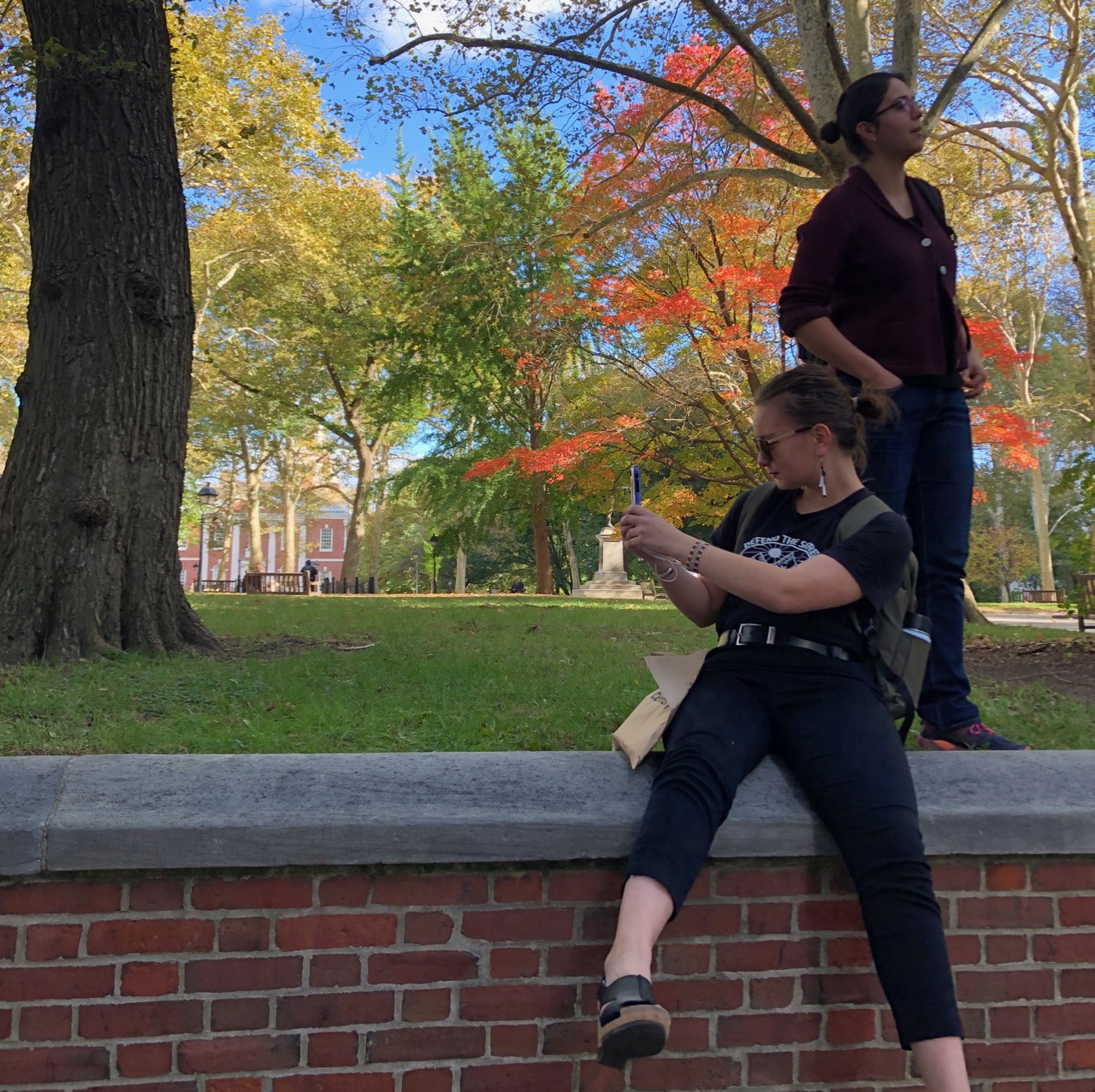
Eleanor Lynch, Lucienne Anderson and Katherine Leinburger
Mentor - Sarah Stanley
Last year the three of us were in a class with Sarah Stanley that was taught both in a classroom at UAF and inside the Fairbanks Correctional Center (FCC). Some students of this class attended UAF and others were incarcerated members of the FCC Women's Writing Workshop. After we finished the class Lucie, Katherine, and I continued to be involved with the Writing Workshop, visiting the FCC and volunteering at community events to share writing from the inside.
Last fall we travelled to Philadelphia to attend the Conference on Community Writing, which is a conference focussed on education and outreach, writing with and engaging groups and parts of our communities that might be excluded from traditional academic settings where writing skills are developed. The conference explored inclusive teaching methods and how to shift power dynamics as an educator. We presented a workshop on teaching in carceral spaces.
The goal of the workshop was to encourage attendees to create inside-outside programs within their own communities, or to inform them of some methods we had found to be successful if they were already involved in similar programs. We brought materials from sessions at the Women’s Writing Workshop and shared them with attendees, and shared a short presentation and video of some principles that we based our program and methods of interaction around. This included a quote by Lilla Watson: “If you have come here to help me you are wasting your time, but if you have come because your liberation is bound up with mine, then let us work together.” After the presentation we discussed successes and challenges that we have had with our program. We discussed difficulties that attendees faced in their own programs, and both offered and asked for advice from one another. The workshop ended with a friendly sharing of knowledge and stories between everyone in the room, some of it funny and some that challenged us to work harder.
URTA New York City Graduate School Auditions
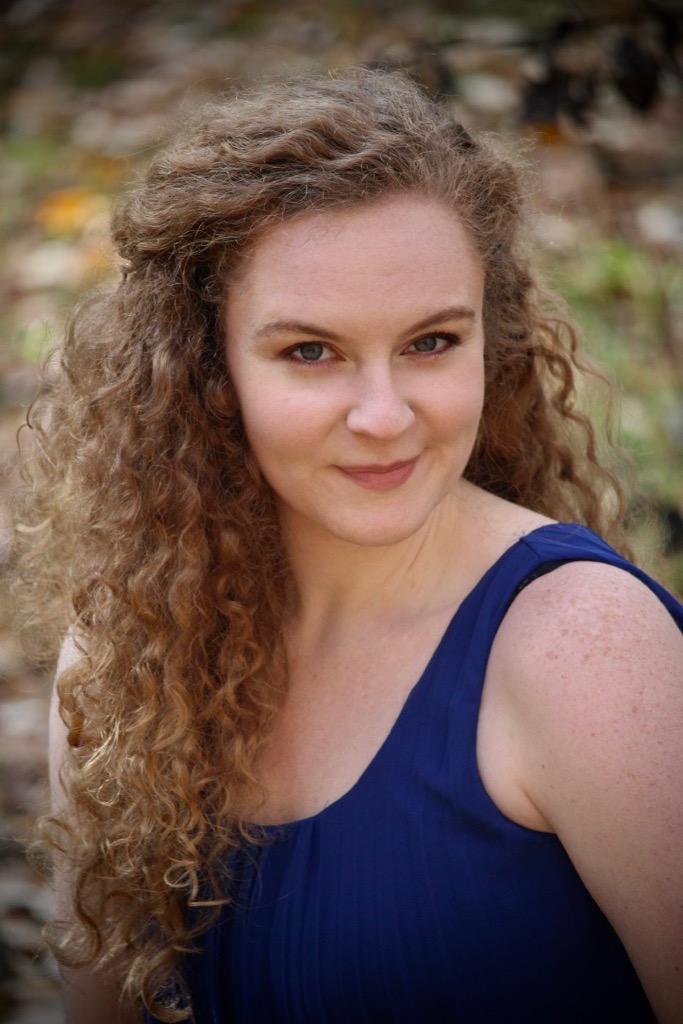
Mary Conlin
Mentor - Carrie Baker
The University/Resident Theatre Association National Unified Auditions is the next
academic step for undergraduate theatre students as it provides an opportunity to
connect with graduate schools, internship programs and even the occasional professional
company. The national and international programs convene in New York City held auditions
this past January 2020 to admit new students. This audition process enabled me to
apply and audition to these Master of Fine Arts (MFA) programs so that I am able to
further develop my career within theatre. These auditions also offer a chance to make
connections with professionals, learn during a variety of hosted workshops, and meet
with recruiters representing national theatre companies.
I was enrolled in a one credit FLPA F498 Research course and Professor Baker and I,
through the course of the semester, we met bi-weekly to prepare myself for the URTA
Unified Audition. A lot of work outside of this schedule is needed in order to be
fully prepared for these auditions. My mentor and I have compiled a 2-minute long
audition package that includes one contemporary and one Shakespeare piece. The contemporary
piece is from Maya by Alaskan playwright, Daniel Damiano, and the Shakespeare piece
is a Helena selection from All’s Well That Ends Well. Additionally, two other monologues
were polished in case a recruiter asked to see more which isn't usually expected.
However, during the callback process I was indeed asked to perform an additional Shakespeare
piece which was a delightfully nerve-wrecking experience. Script analysis was required
for each monologue which includes reading and understanding the text, delving into
the character backgrounds, and comprehending the interpersonal relationships. This
research and preparation has enriched my performance and undoubtedly aided me in gaining
acceptance into a prestigious program interlaced with internship opportunities within
the committing and professional collaborations across the world.
Two Roads
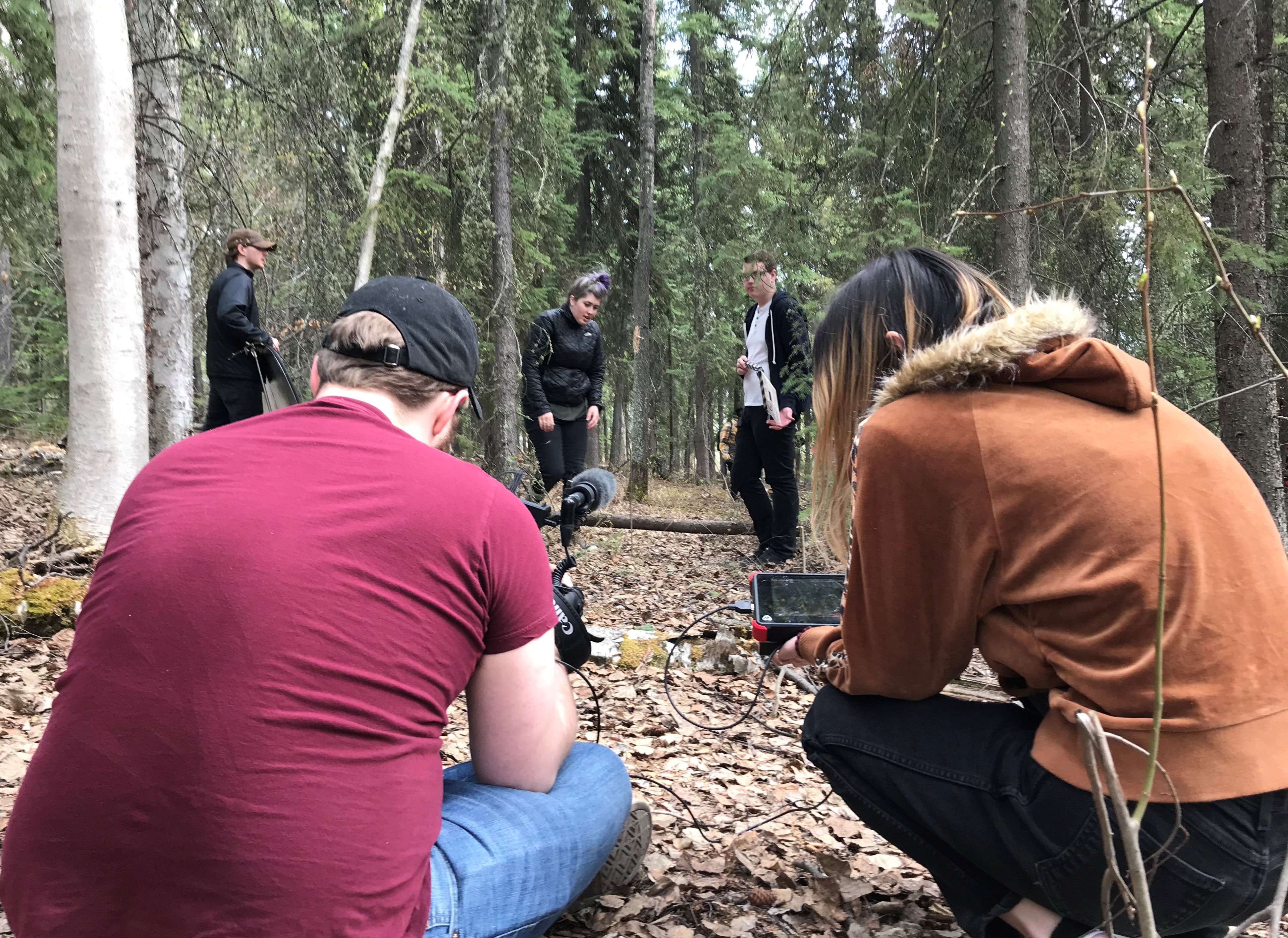
Kyleigh Huntsman
Mentor - Maya Salganek
For this short film I wrote an original script on the theme of two children coming
into a foster how and exploring a short look into what it takes for the parents and
the children to develop trust with one another. I began with a script and worked closely
with my mentor to make edits and adaptations to the limits we have for film making
in Alaska. After that I brought together a crew and held meetings and planning sessions
to create departments in order to more easily delegate the work so that we could move
forward more smoothly. We held auditions for actors and finally put together a cast
and crew in order to move into production. I both produced and directed the short
film over two weeks in May 2019 where I learned a great deal about what it means really
apply the skills I have been learning over the past four years of my education at
UAF. I used this project as my capstone or final project for my degree. It was a learning
curve to go from student to professional. That however is what I most appreciated
about this work through the University of Alaska Fairbanks. I combined my Major in
Film and my Minor in Psychology to create a piece that is both quality entertainment
value, as well as an informative and community outreach project.
In my preparations and pre-production phases, I have learned of the struggles to place
foster children into new homes and the instability that occurs in their worlds as
a result. I hope to make connections and that this project will be able to work closely
with state and private programs that work with the foster care system. My hope is
that this short film will become an advocating resource that will demonstrate that
trust and security are available to all children and that potential foster parents
will understand that with time, training and effort, those who are willing, can provide
a life changing experience for children.
Participatory Action Research in the Social and Cultural Effects of Gamelan Music and Gamelan Ensemble Playing
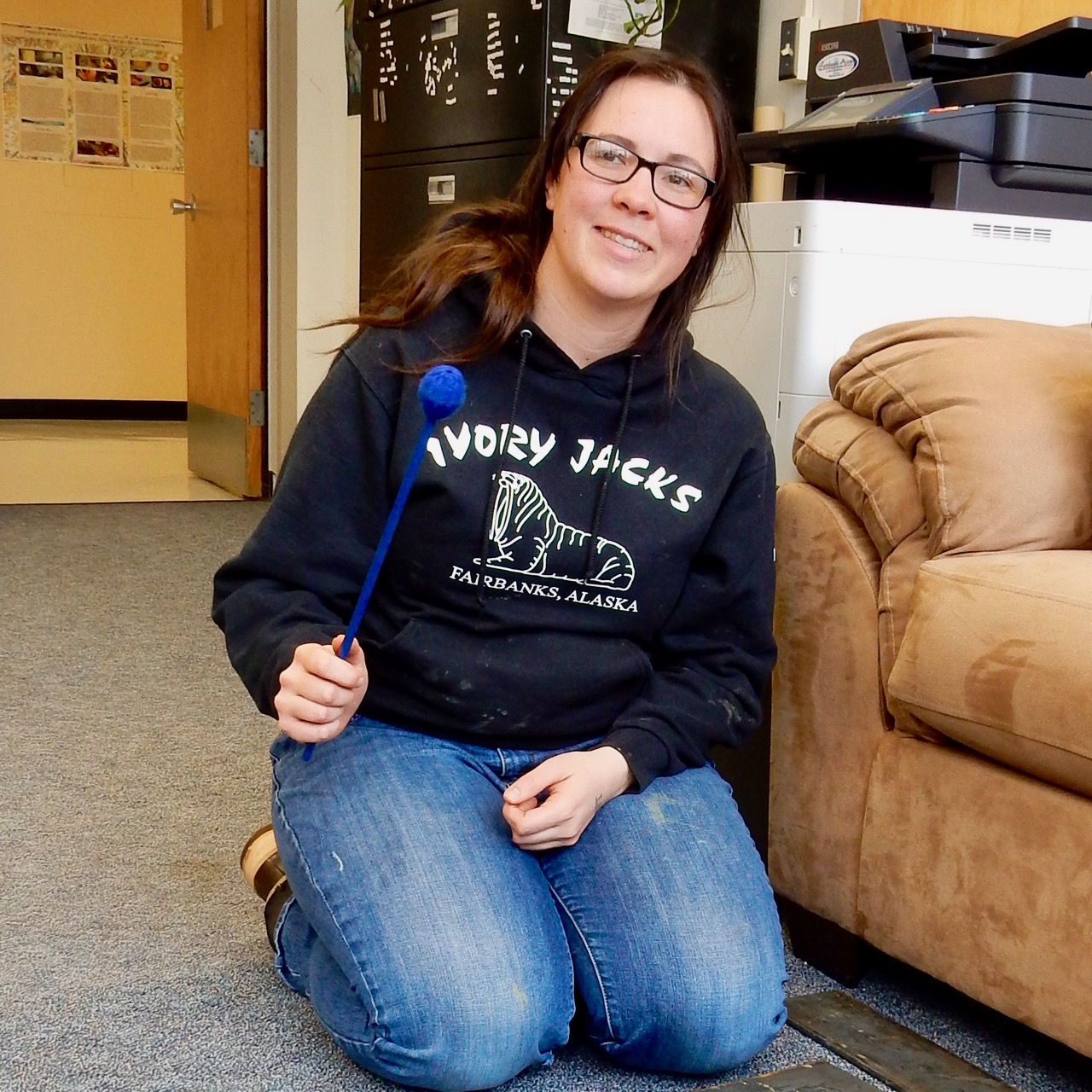
Kellie Lynch
Mentor - Sveta Yamin-Pasternak
The building of a set of Javanese gamelan instruments was a goal of mine since arriving
in Fairbanks to finish my bachelor’s degree in the Music Department at University
Alaska Fairbanks in 2016. It took a few semesters of reading, listening and emailing
other instrument builders before I managed to get enough information and funding to
take on such a large project. To construct the instruments the project included collaborations
with a carpenter and a blacksmith, consultations with physics faculty and the help
of a few volunteers and friends. I relied on the expertise of instrument builders,
Jarrad Powell and Stephan Fandrich for instruction on the minute details of tuning
the steel bars and plates and resonator acoustics.
As an ensemble leader and educator, I reached out across the university and community
to acquire skills in participatory action methods in education and collaboration.
My mentors and teachers are my collaborators, community members and participants each
providing a vital part to my research and education process as I document the process
of participatory methods in community music. This project serves as the capstone of
my undergraduate interdisciplinary degree in Applied Ethnomusicology by utilizing
the skills I have learned in music, Alaska Native cultures and knowledge systems,
anthropology and the importance of community involvement.
Fairbanks has many community music ensembles and cultural events within the Alaska
Native community which celebrate the different music and cultures of the people who
live in Fairbanks. In the use of gamelan, I was looking for something that would have
no barriers of learning in place such as knowing how to read music or owning a certain
instrument to be able to participate. The goal of bringing gamelan music into the
community was to share, equally, a musical experience that would require only the
participants willingness to learn to create music together as an equivalent.
I am continuing to make contacts with other gamelan educators and players in the United
States and Indonesia to further my education in both Javanese gamelan and Javanese
culture. I intend to spend time with gamelan instructors during a visit to Java over
the winter break and bring back more information to my fellow gamelan players to further
our collective knowledge in support of our community gamelan ensemble.
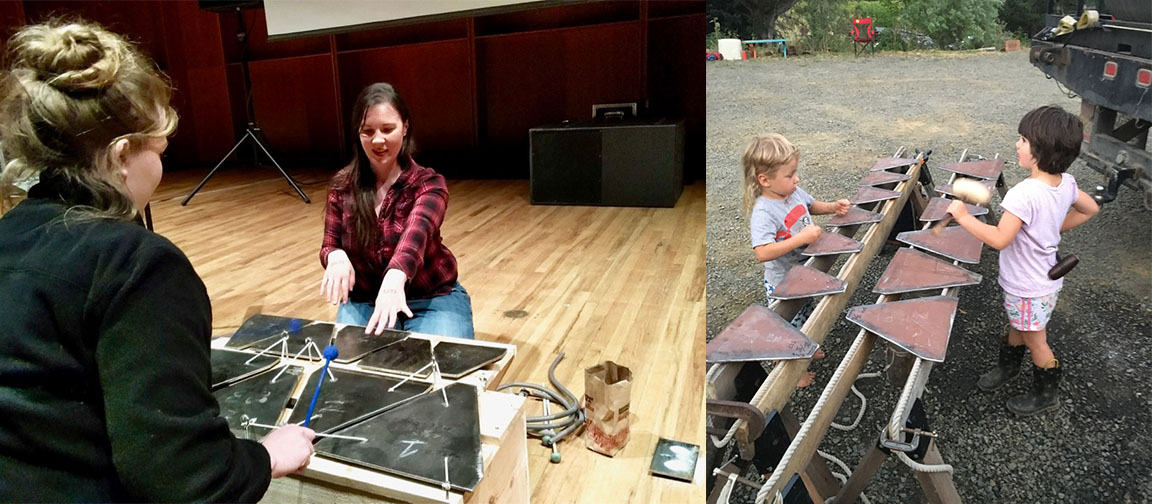
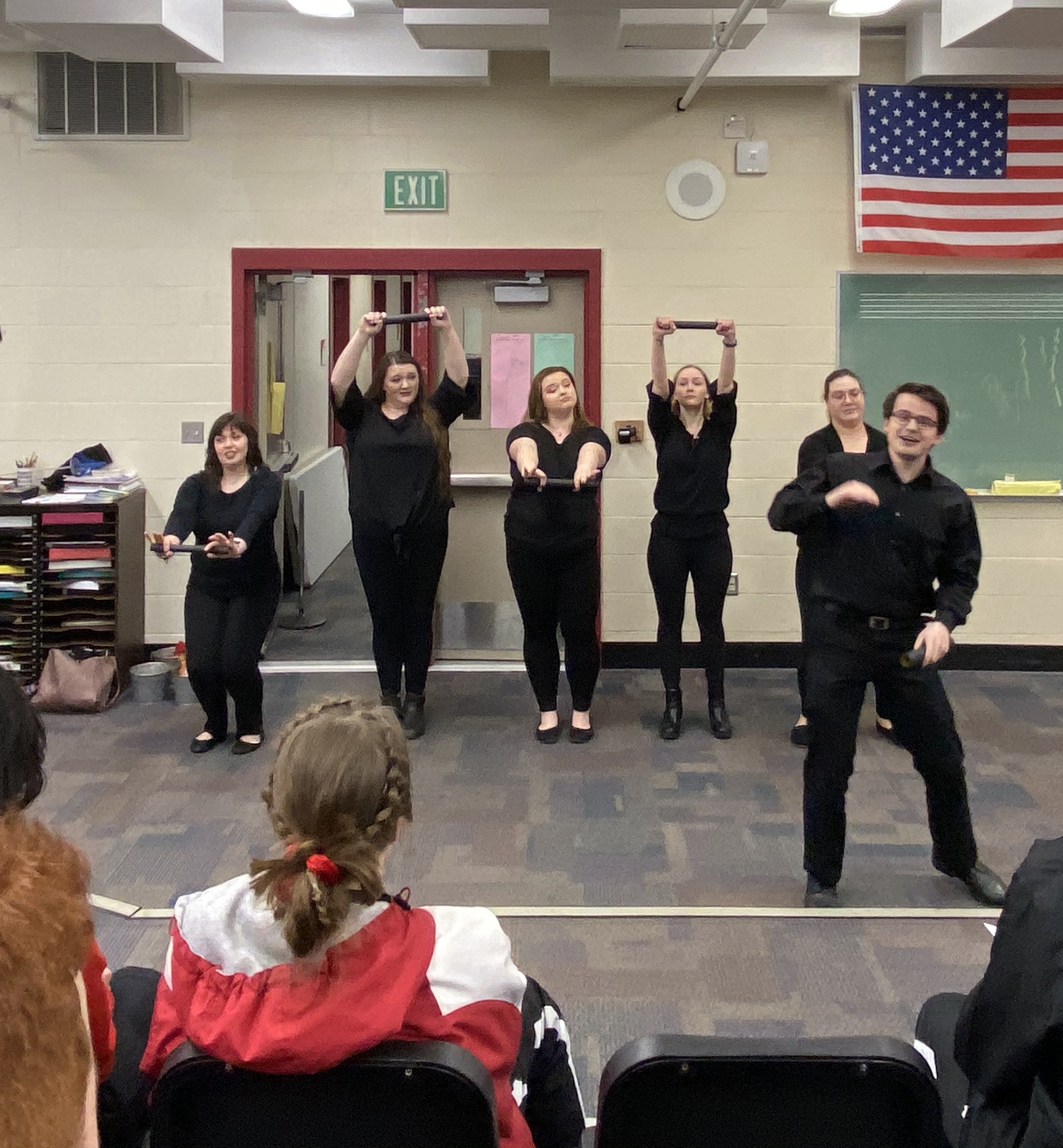 UAF Vocal Department Outreach
UAF Vocal Department Outreach
Madeline Andrieson, Jenna Dreydoppel, Phoenix Williams, Taylor Hendricks, Jonathan
Lange, and Lindsay Moisan
Mentor - Jaunelle Celaire
Our group performed fully staged scenes of Gilbert and Sullivan operettas for secondary and elementary students. Our hope was to reach out and inspire these students to pursue music at UAF and preserve the UA mission in years to come through classical vocal music. Music for the outreach was chosen by Dr. Celaire in June 2019; distributed to the students; and rehearsed during fall semester within the hours of our Opera Workshop class. We traveled to Anchorage and performed in the Wasilla school district as well as the Fairbanks North Star Borough School District. We received wonderful feedback from the students and all learned a lot about staging opera scenes and working with and presenting to primary and secondary students.
The Opera Workshop class learned a total of eight pieces to perform for the schools we visited. The eight we performed were from three different Gilbert & Sullivan operettas, three from The Pirates of Penzance (from which we performed "Oh better far to live and die," "Poor wand'ring one," and "When a felon's not engaged"), three from The Mikado ("Three little maids from school are we," "The sun whose rays are all ablaze," and "Alone, and yet alive"), and two from The Gondoliers ("Oh rapture, when alone together" and "Take a pair of sparkling eyes"). They were choreographed by Bruce Hansen and Nick Nappo.
Defining Sexual Consent in the State of Alaska
Emily Cohen and Aidan Earnest
Mentor - Alex Hirsch
Within Alaska, 59% of adult women have experienced intimate partner violence, sexual
violence, or both, in their lifetime (FBI Crime Report, 2012). Furthermore, Alaska’s
rate of rape per 100,000 people in 2018 was 161.6, more than three and a half times
that of the national average (FBI Uniform Crime Report, 2018). When considering that
these figures are only based on reported incidents, it becomes clear that Alaska faces
an epidemic of sexual violence. This is due, in part, to the fact that Alaska has
no legal standard for consent. Different states within the United States have codified
varying definitions of consent, creating a disparity across the nation in the application
of adequate responses to sexual assault. Defining consent at the state level will
increase awareness of sexual consent for a large amount of individuals who may not
have knowledge of what it is or how to obtain it, as well as provide a legal basis
for determining if a sexual crime was committed, thereby increasing the conviction
rates of sexual offenders. Our general project objective is to decrease the rate of
sexual violence in Alaska. Though our research aims to identify a single, effective
statutory definition of consent, a working definition of consent is an agreement of
willing participants to engage in sexual activity with one another. Through a comparative
analysis of states’ statutory consent laws, we will analyze the sexual crime statistics
before and after consent laws were adopted in order to ascertain the significant impact
of these laws. We will present our findings as our Honors College thesis project and
we will influence the Alaska state legislature to draft and pass a consent law. We
will also make our compiled data sets of the states’ definitions of consent and rates
of rape available to the public, as such data is not easily accessible in one online
location.
The Relationship Between Social Media Exposure and Loneliness in Older Adults
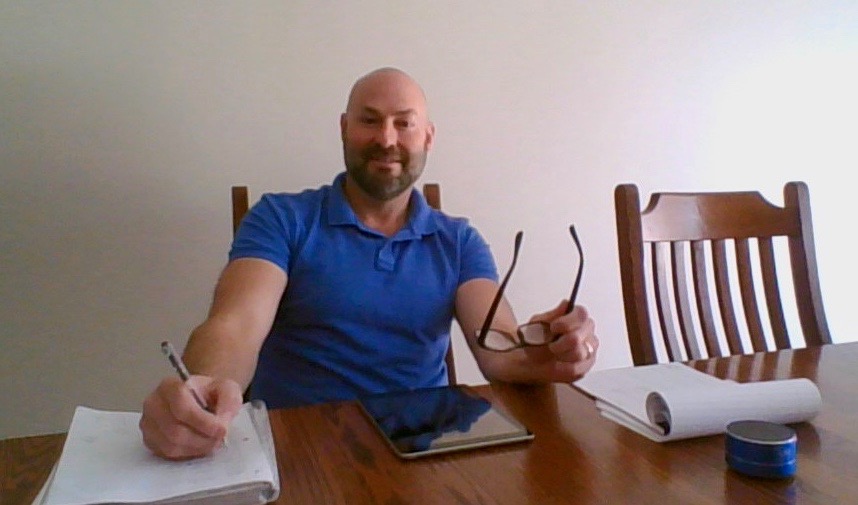
Rodney Tracht
Mentor - Jennifer Peterson
As people age the circumstances that older adults face often leaves them disconnected
from family and friends. According to Hanratty and Valtorta (2012), this new environment
such as assisted living facilities can lead to increased reports of people feeling
isolated and having greater perceptions of loneliness. This study is working to find
out whether increased social media use lowers the perception of loneliness among older
adults aged 60 and over. The exploration of the amount of social media exposure a
person has may help us understand ways in which communication can be adjusted to be
more beneficial. By doing this, it may help older adults receive the benefits of human
contact even with possible physical and psychological barriers. Types of social media
and the amount of exposure per week is being measured, analyzed and compared to perceptions
of loneliness. Participants include older individuals within the United States.
This study utilizes a self-report survey to gather information about older adults,
their perception of loneliness and potential benefits of social media exposure. The
survey is gathering important information including personal well-being and overall
health, personality tendencies and levels of a person’s perception of loneliness.
Also, it gathers information on attending religious services and other types of physical
social gatherings. Advances in computer technology gives older adults the ability
to communicate, establish and maintain relationships through social media websites
such as Instagram and Facebook, despite factors such as geographical distance and
immobility.
Perceptions of loneliness can lead to many detrimental health effects. A study by
Fall et al. found (2019), “Evidence from prospective cohort studies indicates that
loneliness and objectively assessed social isolation combined are both associated
with 30% higher risk of developing coronary heart disease and stroke”. In 2019, Cowie,
Frost and Malcolm stated that there is evidence that loneliness is associated with
dementia, Alzheimer’s Disease, suicide and schizophrenia. Due to this and a myriad
of other evidence suggesting the seriousness of this state of mind, we may find ways
to lessen these circumstances to be especially beneficial.
This study is exploring this realm and seeks to explore the possibilities that increased
use of social media by older adults aged 60 years and older may lower their perceptions
of loneliness. It is gathering important evidence that may lead to a better understanding
of the relationship between isolation, increased feelings of loneliness and possibly
greater risk of disease. The goal of the study is to further this knowledge which
may help in finding beneficial ways in which social media use can be employed by older
adults to potentially happier and healthier lives.
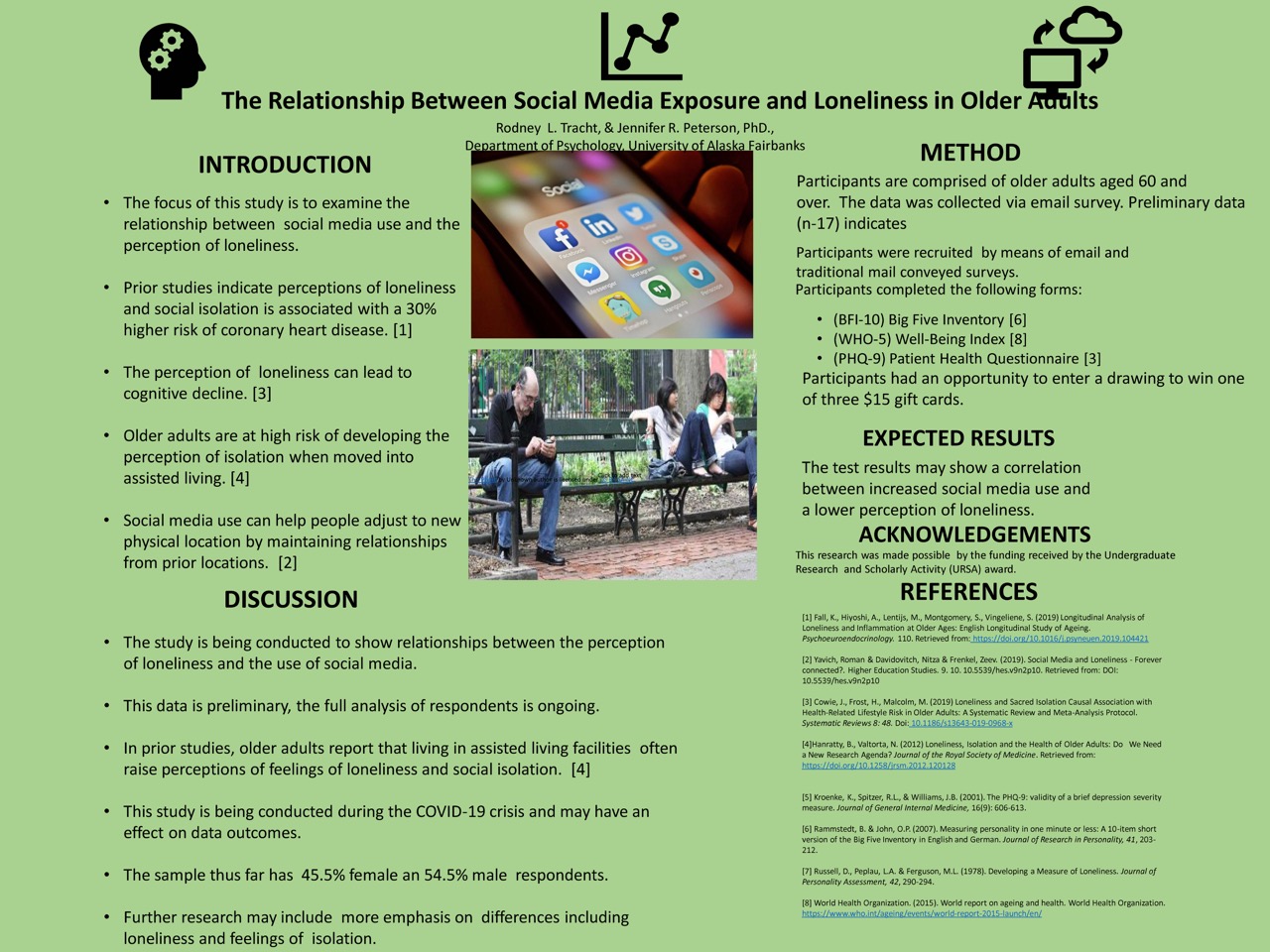
Shedding Light: Factors Related to Well-Being During Winter Across Latitudes
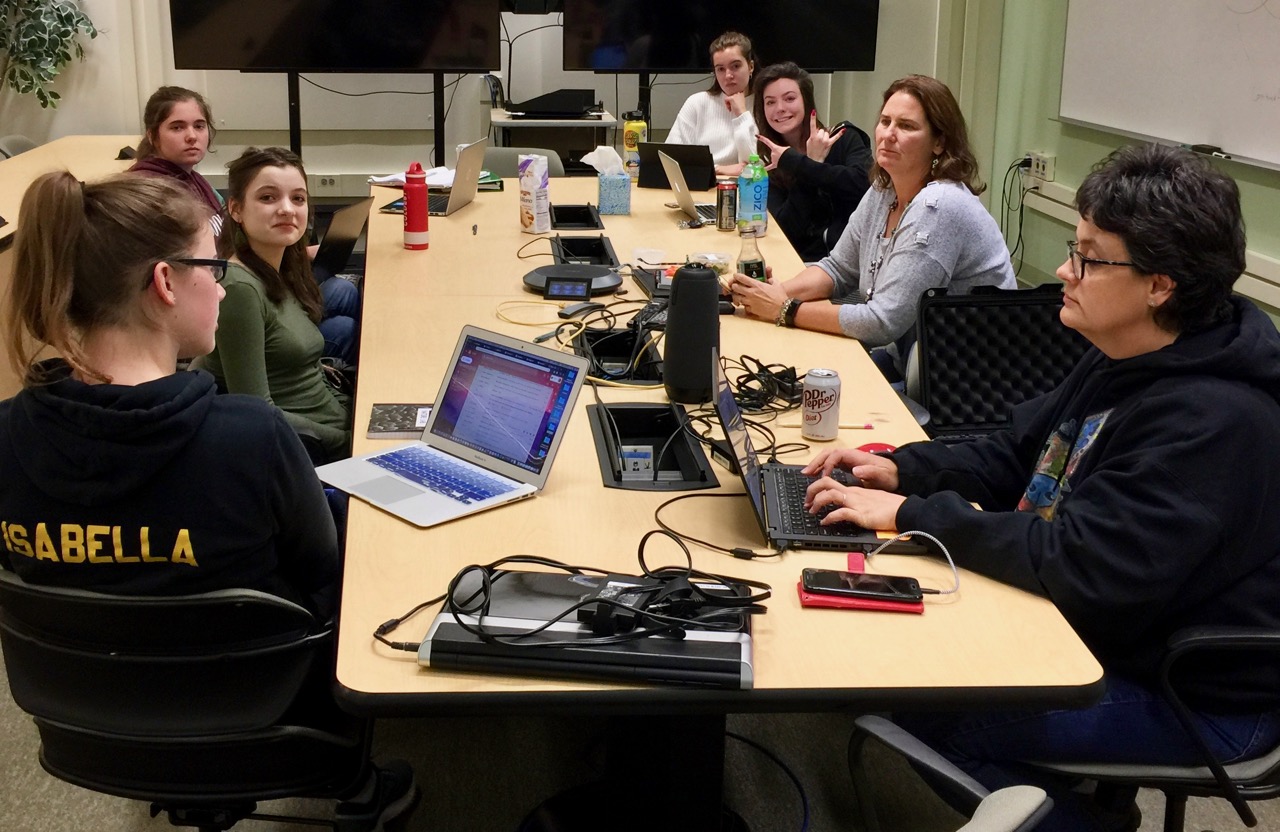
Kayli Breuninger and Sara Levy
Mentor - Dani Sheppard
Alaska is characterized by extreme climate and lighting conditions. Other regions of the U.S. also experience lower light levels during winter. Previous research indicates that limited daylight has a negative impact on behavior, health, mood, and well-being. The current study explored the well-being of residents in Central Alaska (64.8° N, Solstice = ~four hours of distinguishable light) and Western Oregon (44.8° N, ~eight hours at solstice) during winter (December-February) to see whether differences in levels of natural light were associated with measures of overall health. Participants (n = 297) from Alaska (n1 = 156, age range 18-72, 73% female) and from Oregon (n2 = 141, age range 18-79, 76% female) were at least 18 years old and had been living in their respective region for at least two years. Participants completed an electronic survey that assessed behaviors, health, mood, and well-being. The survey also included validated measures such as the Epworth Sleepiness Scale (ESS), Life Orientation Test (LOT), Edinburgh Handedness Inventory (EHI), and WHO Well-being Index (WHO-5). Pearson correlations were used to evaluate relationships among variables. In addition for this study, a “thriving” variable was created using a median split of the overall well-being scores and the overall mood scores. Individuals scoring above the median split in both variables were categorized as “thriving”, those scoring below the median split in either were categorized as “non-thriving.” Logistic regressions were performed on 4 different models of predictors. Results indicated low well-being across states during the winter as measured with WHO-5 (M = 12.8, SD = 4.9 on a scale of 0-25, where a score below 13 is an indication of need for further testing for depression). The difference between Alaska (M = 13.1) and Oregon (M = 12.5) was not significant. Several factors were significantly related to these scores similarly across the two regions: change in bed time, life orientation (positive vs. negative), age, physical activity, propensity for daytime sleepiness, self-reported preference for winter, and self assessment of the role winter plays in well-being and mood. Logistic regression analyses indicated several significant predictors of thriving, including positive relationships with age, time outdoors, physical activity, optimism, liking winter, and preferring winter to summer. Negative relationships included use of light strategies, sleepiness, and sleep changes/difficulties. These winter well-being scores in Central Alaska are lower than previously reported summer scores (M = 16.4). More importantly, the absence of a significant difference between Alaska and Oregon WHO-5 scores demonstrates a shared negative impact of winter on overall well-being across latitudes. In addition, several factors can predict whether someone will thrive in the winter, including personal, behavioral, and psychological factors. These data indicate that public health interventions aimed at combating maladaptive changes associated with the winter months may be generalizable across latitudes. Further, these interventions can be better informed by understanding the role of individual choices, patterns, perceptions, and propensities.
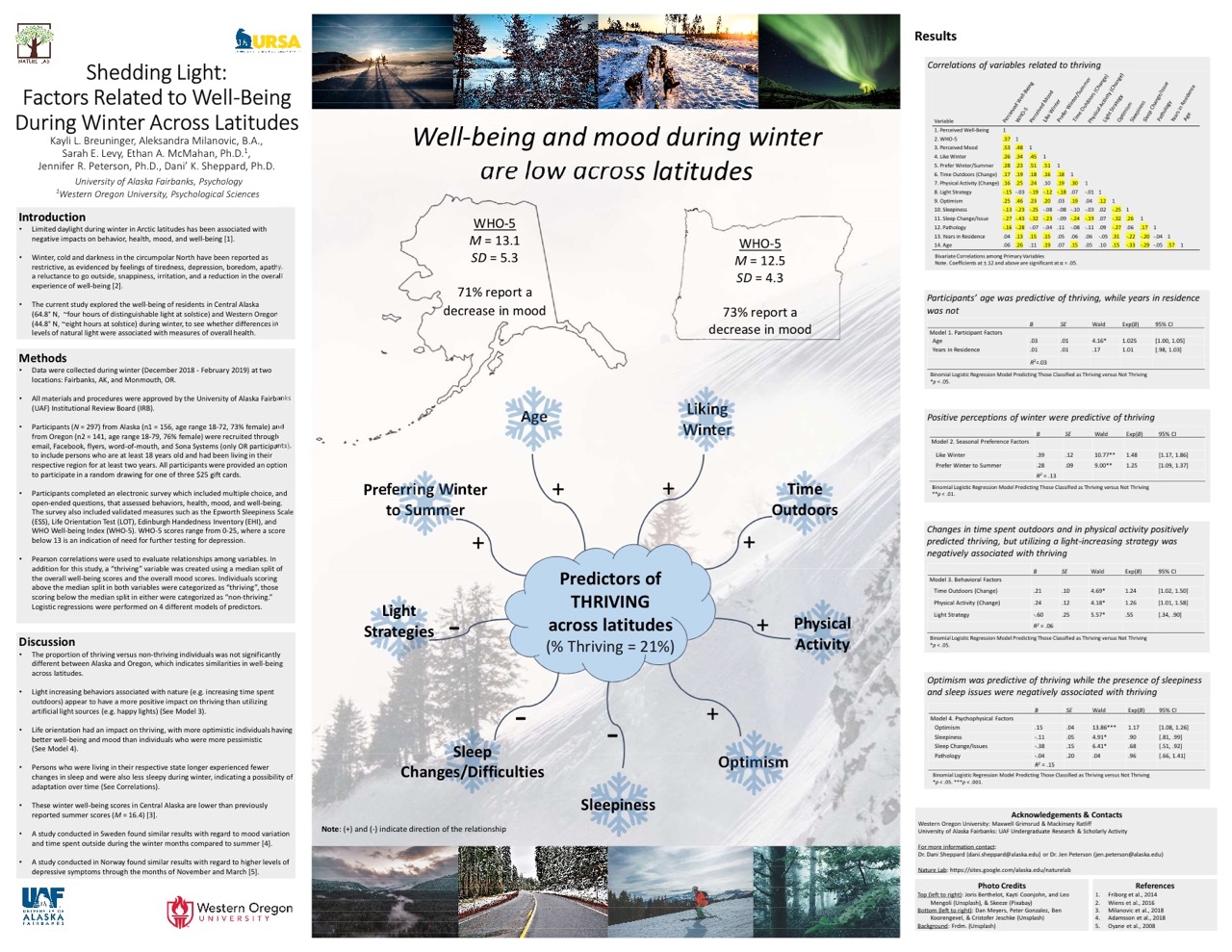
Well-Being and Behavior Patterns During Arctic Equinoxes
Hannah Pothast
Mentor - Jen Peterson
Individuals living at high latitudes risk experiencing season-related shifts in mood,
behavior, cognitive functioning, and socialization patterns, the symptoms of which
are more commonly referred to as seasonal affective disorder (SAD). This study examined
how shifting levels of daylight during transitional seasons correlate to mood and
behavior within a college sample. Participants were asked to wear an Actiwatch, a
watch that closely monitors sleep, light exposure, and activity patterns, for a ten-day
period and complete self-report surveys about their perceived well-being, sleep, and
activity levels.
Since light composition and the amount of daylight is closely correlated with circadian
rhythm function and performance, we predicted that participants would report the perception
of obtaining insufficient or restless sleep since the shifting daylight levels had
interrupted their circadian rhythm. Additionally, we also predicted that individuals
would report the perception of increased moodiness, anxiousness, and/or fatigue as
a result of perceiving their sleep to be low-quality. With the sleep, light exposure,
and activity data collected from the Actiwatches and surveys, any changes in mood
and behavior were analyzed.
The overall results of this study were mixed. In short, we found that people are actually
happier during the spring equinox season than we originally predicted, but sleep efficiency
ratings and activity levels were consistent with our predictions. The WHO-5 survey,
which measures individuals’ perceptions of their mood and well-being, was used and
we discovered that Fairbanks locals indicated a higher quality of life than their
non-local counterparts, which could potentially be due to a built-up resilience to
the rapid changes in daylight each year. Although individuals overall reported feeling
happier as the spring season went on, their activity levels fell and they reported
feeling significantly less active and vigorous, and sleep efficiency ratings across
all participants was very low.
An extensive array of literature exists on Seasonal Affective Disorder during solstices,
but there is a significant gap in the literature on how individuals respond to changing
daylight levels during equinox seasons. While having knowledge about symptoms and
treatment of SAD during solstices is important, developing an understanding of how
equinox seasons affect individuals is also important for several reasons. In examining
how shifting light levels affect mood and behavior, information can be gained on how
people mentally and emotionally prepare for the upcoming extreme seasons. Having this
knowledge, proactive measures can be identified and taken to soften the onset and
symptoms of SAD prior to extreme seasons. Because participants were given copies of
the data their Actiwatch reflects, this study also offers the opportunity for these
individuals to objectively observe their behavioral and mood patterns, understand
how light levels and composition affect them, and possibly make lifestyle adjustments
to more adequately prepare for the loss or addition of more light. The overall importance
of this study is that the collected data reflects the extent to which individuals
are affected by shifting daylight levels at high latitudes, and it offers potential
directions moving forward in being proactive about the prevention and treatment of
SAD.
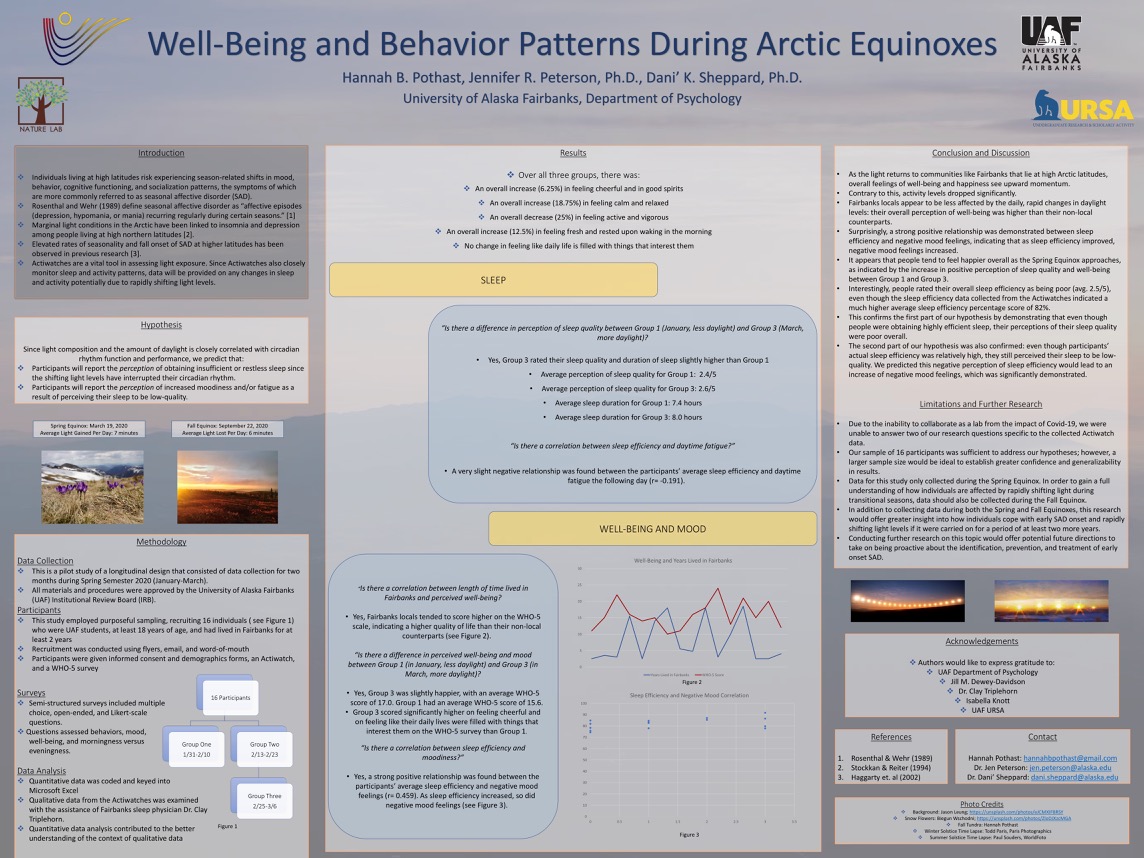
Investigating the Relationship between Pet Ownership and Healthy Aging in Older Adults
Gabrielle Camp, Maren Dodson, Darcy Hoban, Jezebell Ramirez, Leslie Siegfried, Else
Cole and Rodney Tracht
Mentor - Jen Peterson
The One Health model examines human health as interrelation with the health of animals and the environment. The population of Alaska will be composed of 25% seniors by 2030. There are limited resources available to support the psychological and physical health of these elders. Older adults in Alaska face unique challenges of increased risk of isolation and loneliness due to their remote location, extreme weather, and transportation difficulties. Loneliness is highly associated with depression and other indicators of ill-health. These factors necessitate the implementation of healthy aging strategies to improve mood, health, and overall well-being. Pet ownership provides one avenue to promote healthy lifestyles and sources of social support, but little is known about its relationship with elders. The current study is focusing specifically on how relationships between older adults and companion animals enhance and hinder human health.
The FlexCog lab conducted surveys and oral interviews to examine benefits and challenges to pet ownership for participants 60 years of age or older. It should be taken into account that the senior population in Alaska is large and they face challenges as their own population. Alaska has the largest independent living seniors in the nation. The FlexCog lab studied literature that we find indecisive and many fail to mention the challenges and health benefits in relation to pet ownership in the aging population. The Pet Project based at the University of Alaska used demographics, a loneliness scale, WHO index, a personality scale, meaning of life questionnaire, optimism pessimism scale, brief resilience scale, pet attitude scale, PANAS and a mood inventory as written surveys and a semi-structured oral interview.
In this One Health model preliminary data (n=21) were composed of predominantly female (86%) participants, age m= 70.71 years (sd=5.69). The preliminary data also show older participants who have lived in the Fairbanks area for an average of 36 years (sd 14.10). Interesting relationships emerged that show themes of perceived benefits including companionship, routine, and connection. Low themes of challenges include travel limitations, death of a pet and financial costs such as vet bills.
This data is preliminary and is ongoing. The FlexCog lab anticipates this to be one-quarter of the overall sample. This study was done in a small sample from a single location. Future sampling may be more diverse and have more variations in sampling.
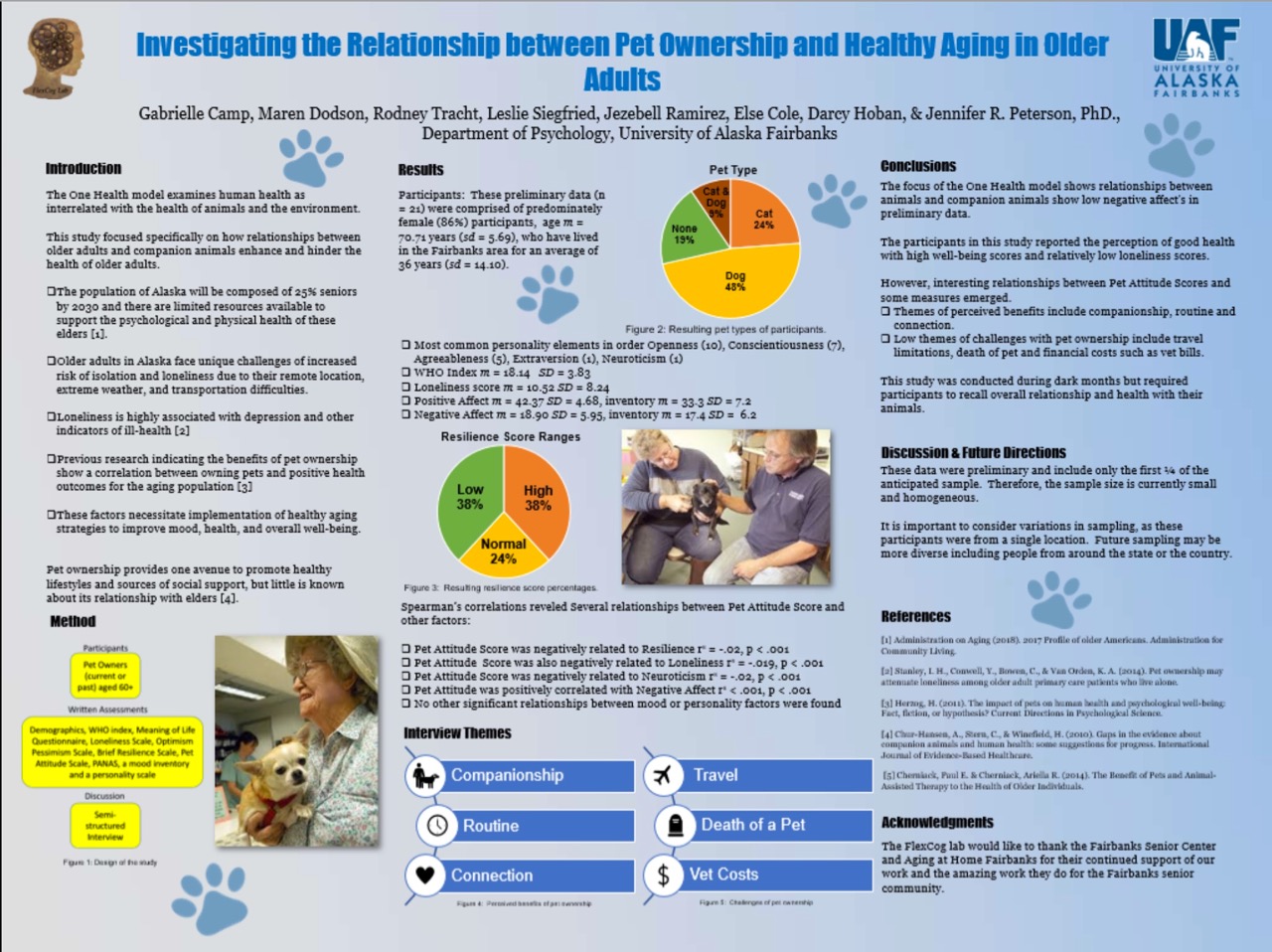

Glass Accents at the Georgeson Botanical Garden Repurposing Fairbanks's Unrecylcled Glass
Lacey Highham
Mentor - Susan Todd
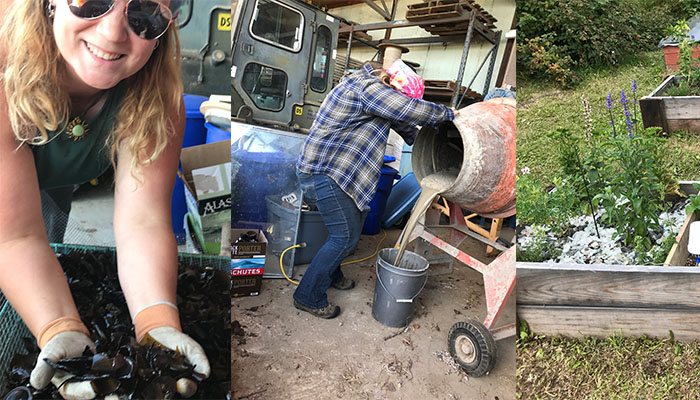
This project was a two-step approach to research the mutual benefits of crushed glass at the UAF Georgeson Botanical Garden. The project held three main goals, 1) determine if a cement mixer could smooth broken glass into glass mulch, 2) study the effects glass mulch has on soil temperature, and 3) examine effects of glass mulch on weed biomass. Glass mulch is recycled glass that is tumbled until it is smooth and roughly the size of a bottle cap. It can be used as glass mulch in gardens, as cement aggregate, and an art medium. This project will test whether this is a sustainable option for repurposing glass in the Fairbanks, Alaska community. The Georgeson Botanical Garden (GBG) is an optimal location for this project because it has the resources needed to succeed and makes an excellent location for public demonstration.
Alaska recycling opportunities are limited and there are no municipal options for recycling glass within the Fairbanks North Star Borough. These limitations leave Fairbanks residents eager for an alternative solution for their glass waste. Communities such as Austin, Texas and Phoenix, Arizona use crushed glass to aesthetically reduce yard vegetation and water needs. Fairbanks can look to these communities for innovative ideas on how to reduce our local glass waste while also studying the biological impacts glass has on soil properties.
During this project more than 2,000 pounds of glass was donated from Fairbanks community members and the Georgeson Botanical Garden and processed through an electric cement mixer until smooth. To study the effects glass mulch has on soil temperature and weed biomass three raised beds were built, filled with soil and topped with glass mulch. Four sensors were used to log 60 days of hourly temperature measurements. Weed biomass was removed prior to glass mulch placement and then mass was recorded at the end of the period and compared to beds with bare soils. This project provides a research platform for investigating repurposed glass applications, cost benefit analysis, and feasibility studies.
The Environmental Consequences of Foreign Direct Investment: Empirical Evidence from the People’s Republic of China
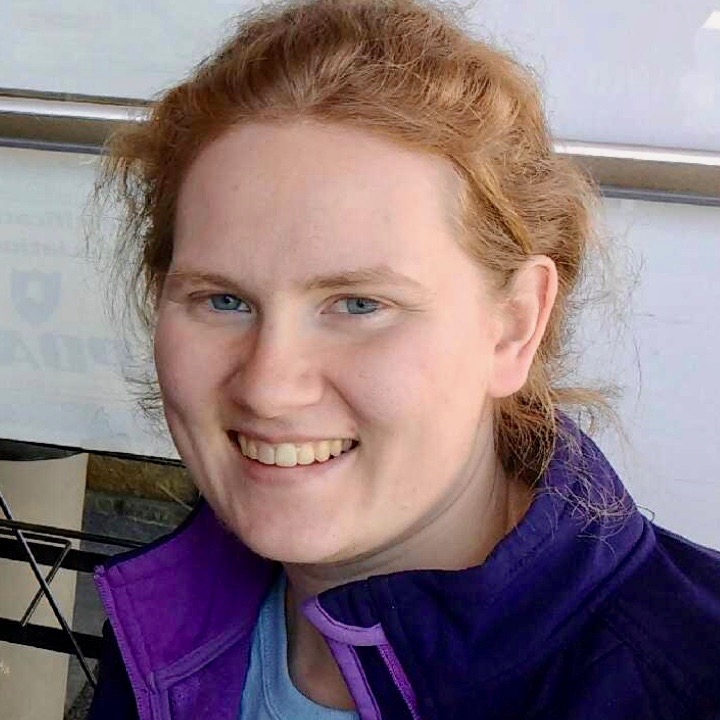
Katelynn Bushnell
Mentor - Jungho Baek
Economists have vigorously debated the environmental consequences of foreign direct
investment (FDI). Some argue that, if developing countries rely on technology transfer
through FDI from developed countries as a primary means of technology acquisition,
the inflow of FDI generally enforces environmental regulations via economic growth,
thereby improving environmental quality. Others, in contrast, fear that if developing
countries utilize lenient environment regulations in a strategy to attract multinational
corporations, particularly those engaged in highly polluting activities from developed
countries, FDI is likely to result in the deterioration of environmental quality.
Therefore, an interesting question arises regarding China’s environment: what are
the environmental consequences of FDI in China?
To answer this question, Professor Baek and I used data from 29 Chinese provinces over 15 years (1998-2012) to model the effect of FDI on the environment, controlling for economic growth and other factors. Since growth in China plays a significant role in determining environmental quality, it was crucial to incorporate the Environmental Kuznets Curve (EKC) hypothesis into the analysis to measure the FDI impact on China’s environment accurately. The EKC indicates that environmental quality deteriorates with growth up to a threshold level beyond which environmental quality improves with growth, thereby showing an inverted U-shaped relationship between growth and environmental quality. Equally important hypotheses to include in the study’s contextual framework were the pollution haven hypothesis, which supposes that pollution-intensive capital is attracted to “pollution havens” overseas to avoid high pollution compliance costs domestically; and the pollution halo hypothesis, which supposes that FDI has positive spillover effects, such as improved energy efficiency, which curb emissions.
The main objective of this research was to model the effects of FDI on China’s environment, controlling for economic growth. In an exploration of the FDI-income-environment nexus, the main hypotheses to be tested were: (1) the inflow of FDI in China deteriorates the environment; (2) economic growth in China improves the environment after a certain point, known as the Environmental Kuznets Curve (EKC) hypothesis. Then, in an effort to better analyze the nexus, we modified our original model to account for additional potential determinants of environmental quality in China. We created two variations of our model to test the following hypotheses: (3) energy consumption led by economic growth deteriorates China’s environment; and (4) urbanization deteriorates China’s environment. The results showed that all but the last of our hypotheses were correct; the variable urbanization was statistically insignificant, so no conclusion could be reached.
All in all, our study determined that the relationship between FDI and SO₂ emissions
is negative on average, meaning that increasing FDI inflows decreases harmful emissions.
This finding confirmed the pollution halo hypothesis rather than the pollution haven
hypothesis. We also found strong evidence for the presence of an EKC, an inverted
parabolic relationship between per capita GDP growth and SO₂ emissions. These findings
suggest that, in order to improve the country’s environmental quality as well as increase
per capita GDP, the Chinese government should continue to encourage foreign companies
in service-oriented industries to invest in China.
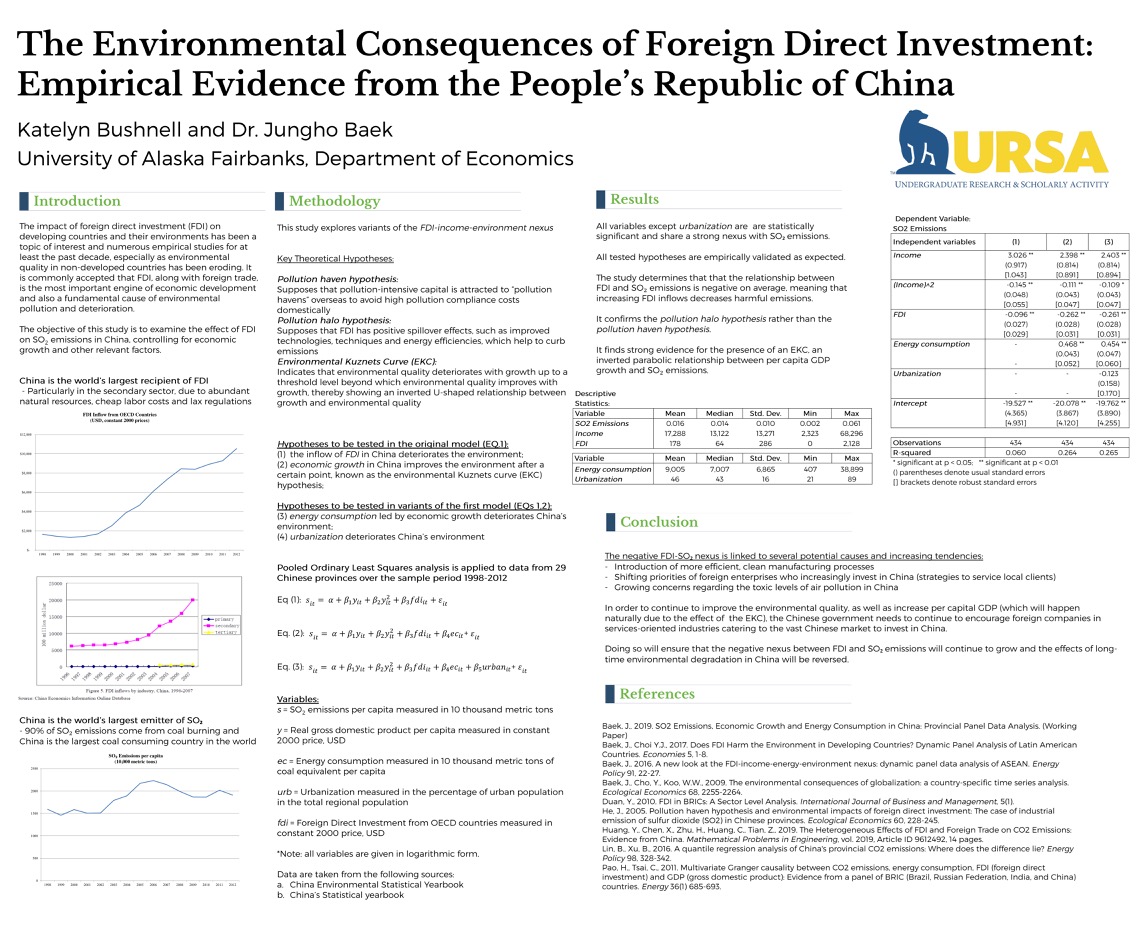
The impact of Emotional Intelligence and Grit on Ethical Decision Making While Hunting
Myha Cortez
Mentor - Maragaret Keiper
It was estimated in 2015 that the total economic activity related to the guided hunting
industry in Alaska was $87.2 million (Safari Club International, 2016). Though hunting
is a significant industry as well as a popular recreational activity in Alaska, it
is often a controversial topic regarding ethics and the legal aspects of hunting,
specifically following the legal regulations set forth. Furthermore, there is a gap
in the literature regarding what influences people to break the law while hunting.
In 1979 Lef Stated “Only if ethics were something unspeakable by us, could law be
unnatural, and therefore unchallengeable. As things now stand, everything is up for
grabs” (p.43). Lef’s conclusion is particularly true with hunting. Though the regulations
are clear on what is legal and what is not, hunting violations still often occur.
The degree of wildlife law violation could be associated with different motivations.
For example, unintentional and minor violations and infractions may be the result
of carelessness or differing ethical viewpoints, whereas serious, blatant offenses
may be attributable to specific motivational categories that induce or cause individuals
to act for specific reasons (Eliason, 2010). One of the ways that states try to mitigate
hunting violations is through hunter education.
All US states and Canadian Provinces have mandatory hunter education requirements.
Hunter education courses often include a section on hunter ethics. However, the courses
do not discuss any aspect of what influences ethical decision making. There is significant
evidence that supports the notion that ethical decision making is influenced by emotions
(Schwartz, 2015). Moreover, there is significant research supporting the influence
of grit on goal achievement. Thus, it was hypothesized that emotional intelligence
and grit both influence ethical decision making while hunting big-game in Alaska.
The theoretical foundation for this research was based on the Ethical Decision Making
(EDM) process. This study was quantitative in nature and had over 200 survey respondents.
The survey included three separate subscales, which were emotional behavior of self,
grit, and emotional intelligence. The research utilized the commonly used Wong’s Emotional
Intelligence Scale, an adaptation of ethical behavior of self from Desphande & Joseph,
200, and Duckworth’s & Quinn’s short-scale measure for grit.
In conclusion, the project gathers data through a survey and how they are being practically applied to hunting regulations. Hunting is a part of lifestyle for many Alaskans in the form of both recreation and vocation. In 2011, it was reported that almost 100,000 Alaska households, went hunting (Woodford, 2014). Furthermore, hunting is also a significant economic driver in the state of Alaska bringing in millions of dollars into the economy yearly. Thus, there is a need to continually develop a shared ethical foundation to protect the social legitimacy of hunting (Fishkin, 1991; Lee, 1993; Stern & Fineberg, 1996; Daniels & Walker, 2001; Peterson, 2003; Peterson, 2004).




